Sexual Harassment in Local Government
Snapshot
Are Victorian local councils providing workplaces that are free from sexual harassment?
Why this audit is important
Sexual harassment in the workplace is unlawful and can cause significant harm to those who experience it. It can also be costly for employers, exposing them to legal liability and increasing staff turnover.
Under the Equal Opportunity Act 2010, employers must take reasonable and proportionate measures to eliminate sexual harassment in their workplaces.
What we examined
We examined whether councils provide their staff and councillors with workplaces free from sexual harassment.
We looked at:
- the prevalence and nature of sexual harassment in councils
- councils’ policies, training and communication
- the effectiveness of councils’ complaint handling.
Who we examined
We audited five councils as a spread of council type and size:
- Ararat Rural City Council
- Corangamite Shire Council
- Frankston City Council
- Latrobe City Council
- Moreland City Council.
We also conducted a sector-wide survey, which received 9 939 responses from council employees and councillors from across 75 councils.
What we concluded
Councils are not providing workplaces that are free from sexual harassment. More than one in four survey respondents said they had experienced workplace sexual harassment in the last 12 months.
Although councils have the tools that could prevent these experiences, they do not use them to their full advantage. A lack of comprehensive policies, training and communication means councils rarely engage staff in meaningful conversations about sexual harassment and its drivers.
This creates a culture where victims lack confidence to report their experiences. For those who do report, complaint handling is undermined by poor documentation and councils’ failure to encourage and support complainants.
What we recommended
This audit report provided eleven recommendations to Victorian local councils and one to the Department of Jobs, Precincts and Regions in relation to identifying and acting on risk factors, regularly collecting data on the prevalence of sexual harassment and the development of regular data collection methodology. All recommendations we made were accepted.
Video presentation
Key facts
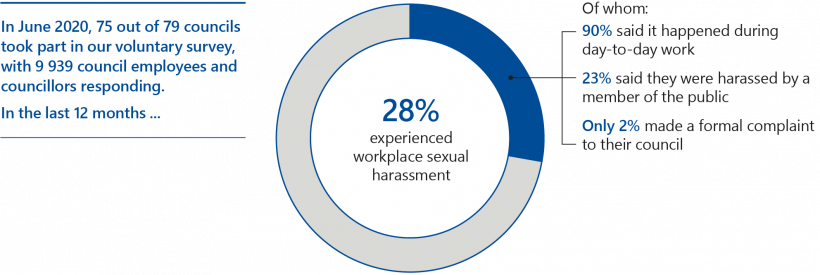
Support options
Sexual harassment can take many forms and result in physical and emotional harm. Our report discusses these issues. If you, or someone you know, have experienced sexual harassment or assault and want support, several options are available.
1800RESPECT—National sexual assault, domestic and family violence counselling service
1800RESPECT provides information, referral and counselling services to people experiencing or at risk of experiencing sexual assault, domestic or family violence. It is also available to friends, family and professionals. 1800RESPECT provides a confidential service 24 hours a day, seven days a week.
Phone: 1800RESPECT (1800 737 732)
Employee assistance programs
Local government employees may have access to employee assistance programs that provide free and confidential short-term counselling for workplace and personal issues. Staff can obtain details of the relevant employee assistance program from their council's human resources team.
Centres Against Sexual Assault
Centres Against Sexual Assault are non-profit, government-funded organisations that provide support, counselling and crisis care to child and adult victims of sexual assault and their family. You can find your local centre by visiting www.casa.org.au.
Lifeline
Lifeline is a national charity providing all Australians experiencing a personal crisis with access to 24-hour crisis support and suicide prevention services.
Phone: 13 11 14
Making a sexual harassment complaint
This audit examines whether local councils provide workplaces that are free from sexual harassment. VAGO does not take or investigate individual complaints. You can make a complaint or seek further information from the following agencies.
Victorian Equal Opportunity and Human Rights Commission
The Victorian Equal Opportunity and Human Rights Commission is an independent statutory body that has responsibilities under several pieces of legislation, including the Equal Opportunity Act 2010. You can contact the Victorian Equal Opportunity and Human Rights Commission to seek information or have your complaint heard.
The Victorian Equal Opportunity and Human Rights Commission may review complaints or refer them to the Victorian Civil and Administrative Tribunal.
Phone: 1300 292 153
Australian Human Rights Commission
The Australian Human Rights Commission is an independent statutory organisation established under Commonwealth legislation. It promotes human rights in Australia and internationally and investigates complaints about discrimination and human rights breaches.
Phone: 1300 656 419
Victoria Police
The role of Victoria Police is to serve the Victorian community and uphold the law. If you have experienced or witnessed a criminal offence, you should report it to Victoria Police via a local police station. In an emergency, dial 000.
Victorian Civil and Administrative Tribunal
The Victorian Civil and Administrative Tribunal hears and decides civil and administrative legal cases in Victoria. Complainants can apply directly to the tribunal to have a complaint about sexual harassment heard.
Phone: 1300 018 228
www.vcat.vic.gov.au/get-started/equal-opportunity
What we found and recommend
We consulted with the audited agencies and considered their views when reaching our conclusions. The agencies’ full responses are in Appendix A.
Understanding sexual harassment in local government
Twenty-eight per cent of surveyed council employees and councillors experienced sexual harassment at work in the 12 months to June 2020.
The margin of error shows how far away results could be from the true value. If the margin of error is ±5 per cent, this means the true value could be up to 5 per cent higher or lower than the value presented.
A confidence level shows how confident we are that the true value sits within the margin of error.
The margin of error for respondents with disability is ±7 per cent.
Unless specified otherwise, the data in this report has a margin of error of ±5 per cent or less at a confidence level of 95 per cent. This means we can be confident that our survey (VAGO LG Survey 2020) results reflect the experiences of council staff. However, as with any survey, it is important to understand results in the context of the methodology and response rate. Appendix E provides this detail.
Employees at higher risk
Employees from all roles and levels said they had experienced sexual harassment. But based on our survey results, those at greater risk were:
- lesbian, gay, bisexual, trans and gender diverse, queer, questioning, intersex and asexual (LGBTQIA+) persons (48 per cent experienced sexual harassment)
- young women (42 per cent of women aged between 18 and 34 experienced sexual harassment)
- people with disability (41 per cent experienced sexual harassment).
Context of experiences
Understanding the context of sexual harassment is important. It helps councils to identify the drivers behind it and the settings that present the most risks to employee safety. Our survey found that sexual harassment in councils was most likely to occur during day-to-day work. Ninety per cent of respondents who had experienced sexual harassment said it occurred in that context.
The types of sexual harassment that respondents experienced differed. In line with the findings of the Australian Human Rights Commission’s (AHRC) 2018 report Everyone’s business: Fourth national survey on sexual harassment in Australian workplaces (AHRC National Survey 2018), our survey found that the most common types were:
- intrusive questions about respondent’s personal life or appearance
- sexually suggestive comments or jokes that made them feel offended
- inappropriate staring or leering that made them feel intimidated.
Regardless of the context, sexual harassment could have harmful impacts on those who experienced it:
- 25 per cent of respondents who experienced sexual harassment said it negatively impacted their mental health.
- 21 per cent said it lowered their self-esteem and confidence.
Harassment from members of the public
Harassers were most likely to be a co-worker at the same or more senior level. However, sexual harassment from the public also poses a significant risk, especially for employees in customer-facing roles such as:
- aged-care workers
- customer service personnel
- library staff
- pool attendants.
Forty-five per cent of customer-facing employees who had experienced sexual harassment said that a member of the public harassed them.
Except Ararat Rural City Council (Ararat), audited councils' sexual harassment policies and complaint procedures do not mention harassment from customers or members of the public, and so do not address this risk. Additionally, some survey respondents said there is a culture of accepting harassment from the public as part of providing customer service.
Collecting information about sexual harassment
The audited councils do not regularly collect information about the prevalence and context of sexual harassment in their workplaces. None of the five audited councils:
- regularly survey employees about their experiences of sexual harassment at work
- categorise complaints in a way that allows them to identify trends in sexual harassment.
Unlike in the Victorian public service, there is no regular sector-wide survey about sexual harassment or workplace conduct. As a result, aside from our survey, councils have no visibility over the sexual harassment that occurs in their workplaces. Without this information, councils cannot plan and implement the actions necessary to protect their employees or identify trends.
LGV is part of the Department of Jobs, Precincts and Regions. It works with councils to improve practices, provides policy advice to the Minister for Local Government and oversees relevant legislation.
The lack of information will also make it difficult for councils to comply with their new obligations under the Gender Equality Act 2020. From June 2021, councils must measure and report on their progress on seven gender equality indicators, one of which concerns workplace sexual harassment.
To help participating councils address sexual harassment, we shared their de identified survey results with their mayor and chief executive officer (CEO).
We did not audit Local Government Victoria (LGV). However, in consultation with LGV, we have directed a recommendation to LGV to help address the lack of sector-wide information about sexual harassment.
Recommendations about the prevalence of sexual harassment
| We recommend that: | Response | |
|---|---|---|
| All Victorian councils | 1. use findings from the Victorian Auditor-General's 2020 Sexual Harassment in Local Government survey to identify and act on risk factors for council employees and workplaces (see Sections 2.1, 2.2 and 2.3). | Accepted by all audited councils |
2. collect information about the prevalence and nature of sexual harassment at least once every two years by:
|
Accepted by all audited councils | |
3. address the risk of sexual harassment by members of the public by:
|
Accepted by all audited councils | |
| Local Government Victoria (Department of Jobs, Precincts and Regions) | 4. coordinate discussions with relevant state government authorities, local government peak bodies and councils about the development of a regular data collection methodology to measure the sector-wide prevalence and nature of sexual harassment (see Section 2.6). | Accepted |
Preventing sexual harassment
Under the Victorian Equal Opportunity Act 2010, employers have a positive duty to prevent and eliminate sexual harassment in their workplaces. This means councils must take reasonable and proportionate steps to prevent sexual harassment occurring, rather than only respond after it occurs.
Policies
In 2018 the Victorian Public Sector Commission (VPSC) released the Model Policy for the Prevention of Sexual Harassment in the Workplace (the model policy). Although it is not compulsory for councils, the model policy outlines the key elements of a comprehensive sexual harassment policy.
All audited councils have policies covering sexual harassment, but they are usually included within broader documents about bullying, appropriate workplace behaviour and discrimination. As a result, policies:
- miss key elements from the model policy that would make them more comprehensive, such as information on bystander interventions and online harassment
- do not provide all relevant information in one document, making them difficult for users to navigate.
Despite these gaps, councils make their policies accessible for staff. Across the sector, 90 per cent of respondents said they knew where to find their council's policy on sexual harassment.
Training
Although all five audited councils provide training on appropriate behaviour, this training is not as effective as it could be because:
- most staff only complete online refresher courses, meaning they miss out on the open discussion and in-depth content of face-to-face training
- training materials do not cover how bystanders can intervene or challenge inappropriate behaviour
- four councils do not tailor training to reflect their own policies and procedures
- three councils do not provide training for managers on how to respond to complaints of sexual harassment.
Face-to-face training does not require employees to meet in person. Live online sessions, where respondents can engage in conversation and ask questions, can achieve the same benefits.
Across the sector, training is not reaching everyone who needs it. Almost one in four survey respondents said they had never received training on appropriate behaviour at their current council.
Casual employees were least likely to receive training. Providing training for casual employees at councils is important because the insecure nature of their employment may present a barrier to reporting.
Impact of training
Without effective training, councils lack a critical tool to prevent sexual harassment and encourage reporting. Respondents who received training were more likely to:
- know how to make a complaint of sexual harassment (89 per cent of respondents who received training compared to 69 per cent of those who did not)
- believe their council takes sexual harassment seriously (83 per cent of respondents who received training compared to 60 per cent of those who did not).
Training is also a valuable tool to increase understanding of sexual harassment and challenge views that excuse or trivialise it. Our survey found that these views exist in councils. For example, 9 per cent of survey respondents did not believe that the unwanted behaviours listed in our survey were sexual harassment. In addition, some survey respondents described victims as being too sensitive.
Leading a culture of respect
Training and policies are not effective if leaders do not visibly promote a culture of respect at the council. There is not enough communication from council leaders to promote this culture:
- None of the five audited councils could provide evidence of communication from senior council staff, CEOs or mayors about sexual harassment or inappropriate behaviours.
- Only 31 per cent of respondents across the sector said their council communicates to them annually about how it is addressing sexual harassment.
Survey respondents also gave examples of leaders not modelling respectful behaviour or calling out sexual harassment, reducing respondents' trust in their council. Almost one in four respondents did not believe, or did not know whether, their council takes sexual harassment seriously.
Recommendations about the prevalence of sexual harassment
| We recommend that: | Response | |
|---|---|---|
| All Victorian councils | 5. introduce a standalone sexual harassment policy that:
|
Accepted by all audited councils |
6. introduce mandatory training on sexual harassment, or improve existing training, so that at a minimum it:
|
Accepted by all audited councils | |
| 7. communicate a culture of respect in the council by ensuring leaders model respectful behaviour at all times and communicate to all staff at least annually that the council does not tolerate sexual harassment (see Section 3.3). | Accepted by all audited councils |
Responding to sexual harassment
Encouraging complaints
All five audited councils have informal and formal pathways for sexual harassment complaints, allowing complainants to choose the option that suits them. However, these pathways are underutilised. Only 2 per cent of respondents across the sector who experienced sexual harassment made a formal complaint, and only 10 per cent told a manager.
In an informal process, parties resolve the issue through discussion or mediation. A formal process includes an investigation to establish what occurred along with documented findings and outcomes.
The most common reasons respondents gave for not making a complaint are that they thought:
- the behaviour was not serious enough
- it would not make a difference if they reported it.
Victims may feel more comfortable reporting sexual harassment anonymously. Anonymous complaints provide useful insights on cultural and behavioural issues, even if councils often cannot complete a complaints process with them.
Despite this, only one of the audited councils—Ararat—now allows employees to make anonymous complaints. In response to our audit, Ararat introduced anonymous reporting to its Staff Grievances Policy in August 2020.
Handling complaints
Consistent and fair handling of sexual harassment complaints is critical to meeting a council's positive duty to eliminate sexual harassment.
Three of the five audited councils had at least one documented sexual harassment complaint in the past five years. Each of these had elements of fair and effective complaint handling, including collecting witness statements and ensuring procedural fairness to respondents. However, we found gaps that undermined audited councils' complaint handling, including:
- not informing complainants of the outcome of their complaint
- investigators misunderstanding the legal definition of sexual harassment
- incomplete complaint documentation, including no records of decisions to discontinue an investigation
- failing to support reluctant complainants to continue with their complaint when they expressed reservations.
These gaps may have negative impacts on complainants and expose councils to liability if their decisions are challenged.
Recommendations about responding to sexual harassment
| We recommend that: | Response | |
|---|---|---|
| All Victorian councils | 8. encourage reporting of inappropriate behaviour by:
|
Accepted by all audited councils |
9. improve record keeping of sexual harassment complaints by:
|
Accepted by all audited councils | |
10. review complaint procedures to ensure they include:
|
Accepted by all audited councils |
Councillors
Councillors experience sexual harassment at a similar rate to council employees, but they receive less support and have fewer options to report it. Forty-one councillors across the state, or 30 per cent of councillor respondents, said they had been sexually harassed at work in the last 12 months.
The margin of error for councillors is ±8 per cent.
Compared to employees, councillor respondents were:
- more likely to be harassed by a councillor or a member of the public
- less likely to receive training
- less likely to know how to access their council's employee assistance program (EAP) for support.
Forty-four per cent of female councillors said they had been sexually harassed in the last 12 months, compared to 19 per cent of male councillors. This can contribute to a culture where women may not seek re-election, making it challenging to address their under-representation in councils. Prior to the October 2020 elections, only 38 per cent of councillors were women, and 13 councils had only one female councillor. This increased to 44 per cent in the October 2020 elections.
Complaint pathways for councillors
From the October 2020 council elections onwards, there are standards of conduct that all councils must include in their Councillor Code of Conduct. These standards prohibit sexual harassment.
At the time of our audit, councillors lacked access to the same informal complaint pathways as employees. Councillor Codes of Conduct at the audited councils were not suited to address sexual harassment because:
- except for Ararat, they require councillors to first attempt to resolve disputes between themselves, making it challenging if a councillor has a complaint against another councillor
- they do not advise councillors that they can make complaints to external bodies, such as the Victorian Equal Opportunity and Human Rights Commission (VEOHRC) or Victoria Police.
Changes to local government legislation mean that councillors can refer any alleged breaches of the standards of conduct, including sexual harassment, to an independent arbiter without first attempting to resolve disputes between themselves.
Recommendations about councillors
| We recommend that: | Response | |
|---|---|---|
| All Victorian councils | 11. ensure councillors receive training on sexual harassment at least twice per council term (see Section 3.2) | Accepted by all audited councils |
12. ensure councillors are informed of their internal and external options for sexual harassment support and complaints, including:
|
Accepted by all audited councils |
1. Audit context
Sexual harassment in the workplace is unlawful and can have significant negative effects on individuals and their employers. In some cases, sexual harassment is also a criminal offence.
The AHRC National Survey 2018 showed that sexual harassment is common in Australian workplaces. One in three people reported being sexually harassed at work in the past five years.
Under the Equal Opportunity Act 2010, organisations must take reasonable and proportionate measures to eliminate sexual harassment in their workplaces. This audit examines the effectiveness of those measures by Victorian local councils.
This chapter provides essential background information about:
1.1 What is sexual harassment?
The Victorian Equal Opportunity Act 2010 defines sexual harassment as any unwelcome behaviour of a sexual nature that makes a person feel offended, humiliated, and/or intimidated.
Sexual harassment can be physical, verbal or written. Examples include:
- comments about someone’s private life or appearance
- sexually suggestive behaviour, such as leering or staring
- brushing up against someone, touching, fondling or hugging
- sexually suggestive comments or jokes
- displaying offensive images or objects
- repeated requests to go out on dates
- requests for sex
- sexually explicit emails, text messages or posts on social media
- sexual assault, indecent exposure, physical assault, and stalking (which are also criminal offenses).
Whether the harasser intended to offend is not relevant. What is important is whether a reasonable person would anticipate that the other person would be offended. A single incident can be enough to constitute sexual harassment; it does not need to be a pattern of behaviour.
1.2 Why this audit is important?
Sexual harassment in the workplace has negative impacts for individuals, groups, organisations and the broader community. As part of the 2018 AHRC National Inquiry into Sexual Harassment in Australian Workplaces (AHRC National Inquiry), the Australian Department of the Treasury commissioned an independent study which estimated that workplace sexual harassment cost the Australian economy $2.6 billion in lost productivity and $900 million in other costs, such as to the health system, legal costs and agency investigations.
Impact on individuals
Sexual harassment can make victims feel unsafe and affect their ability to participate in their workplace. Victims of sexual harassment can experience:
- harm to their mental health
- negative financial impacts
- negative impacts on personal and family relationships.
Vicarious trauma is trauma experienced by those close to a victim or traumatic event from witnessing pain or fear. Burnout is a state of physical or emotional exhaustion from work related stress that involves a reduced sense of accomplishment and loss of personal identity.
These impacts can be short or long term and can damage a person's career and livelihood. Bystanders and other impacted employees can experience vicarious trauma, stress or anxiety and 'burnout'.
Impact on employers
Councils can experience economic loss and reputational damage as a result of sexual harassment through:
- litigation
- increased insurance premiums
- high staff turnover
- reduced productivity
- decreased faith in council management.
Sexual harassment can be both a symptom and a cause of poor culture, leading to lower staff morale and a less enjoyable workplace.
1.3 Prevalence
Understanding the prevalence of sexual harassment in a workplace is a key step in effectively eliminating it. This includes who is doing it, where it is happening and whether victims are reporting it.
The AHRC National Survey 2018 found that 39 per cent of women and 26 per cent of men had experienced sexual harassment at work in the previous five years.
1.4 Preventing sexual harassment
In Victoria, employers have a positive duty to prevent and eliminate sexual harassment in their workplaces under the Equal Opportunity Act 2010. This means employers must take proactive steps to stop sexual harassment occurring, rather than only respond after it occurs.
|
Preventative measures include … |
so that employees understand … |
|
comprehensive sexual harassment policies |
|
|
effective training |
|
|
communication from senior leadership |
|
|
addressing backlash to cultural change |
|
1.5 Complaint handling
It is essential that employees feel safe to make a complaint of sexual harassment. Different avenues to make complaints ensure victims have a choice about what process they want to use to resolve their complaint. The AHRC National Survey 2018 found that less than one in five people who had experienced sexual harassment had reported it.
|
It is important for councils to … |
in order to … |
|
handle complaints fairly |
|
|
document the complaint and how they responded |
|
1.6 Relevant agencies
As employers, councils are responsible for preventing and responding to sexual harassment in their workplace. A range of government agencies and peak bodies support and guide councils, as outlined in Figure 1A.
FIGURE 1A: Relevant agencies
| Agency | Responsibility | Activities |
|---|---|---|
| AHRC | Protecting and promoting human rights in Australia and internationally |
|
| Australian Local Government Women's Association (ALGWA) | Furthering women's participation, knowledge and understanding of the function of local government |
|
| LGV (part of the Department of Jobs, Precincts and Regions) | Regulating and supporting councils on behalf of the state government |
|
| Municipal Association of Victoria (MAV) | Advocating for councils in Victoria as their peak body |
|
| VEOHRC | Protecting and promoting human rights according to Victoria’s human rights laws |
|
Source: VAGO.
VPSC is a government agency that aims to strengthen the effectiveness, efficiency and capability of the public sector. Although VPSC does not oversee local councils, it provides valuable resources that councils can use, such as the model policy. VPSC also runs the People Matter Survey (PMS), an annual workforce survey of Victorian public service employees, which covers a range of workplace issues, including sexual harassment.
1.7 Legislation, policy and guidance
Complying with the positive duty
In August 2020, VEOHRC updated its guidance on complying with the positive duty to eliminate sexual harassment. The Guideline: Preventing and responding to workplace sexual harassment—Complying with the Equal Opportunity Act 2010 (VEOHRC Guideline) sets six minimum standards that employers should meet to fulfil their positive duty to eliminate sexual harassment. Those standards are for organisations to:
- understand their obligations under the Equal Opportunity Act 2010
- have a prevention plan
- build organisational capacity
- manage risks
- respond to sexual harassment reports consistently and confidentially, holding harassers to account and ensuring processes are victim-centric
- regularly review, evaluate and improve outcomes and strategies for preventing and addressing sexual harassment.
Being victim-centric means giving the complainant a say in the process, ensuring they are properly supported and that they are not penalised for making a complaint.
The role of councillors
Residents and ratepayers elect councillors for their municipality every four years. Once elected, councillors are responsible for:
- setting the overall direction for the municipality through long-term planning and decision-making
- appointing the council CEO and managing their performance.
Sexual harassment by a councillor towards a fellow councillor or an employee of the council is unlawful under the Equal Opportunity Act 2010, just as for employees. However, as they are not contracted employees, councillors are not subject to the same internal disciplinary procedures as staff. For example, a CEO cannot dismiss a councillor.
The Workplace Injury Rehabilitation and Compensation Act 2013 sets out how employees can access compensation for workplace injuries, including those caused by sexual harassment. This legislation considers councillors to be employees of the council who can access compensation for workplace injuries.
Councillor conduct
In March 2020, the Local Government Act 2020 came into effect, replacing the Local Government Act 1989. The new legislation aims to improve local government democracy, accountability and service delivery.
Under section 139 of the Local Government Act 2020, councils must approve a Councillor Code of Conduct within four months of a local government election. This code sets out expectations for councillor behaviour during each four-year term and may include any other matters that the council considers appropriate, such as internal dispute resolution procedures. From the October 2020 elections, these codes must explicitly reference sexual harassment and include mandatory standards of conduct for councillors. These standards specifically prohibit sexual harassment.
Divisions 5 and 7 of Part 6 of the Local Government Act 2020 provide arrangements for dealing with councillor misconduct, including breaches of the Councillor Code of Conduct. Figure 1B summarises these.
FIGURE 1B: Councillor misconduct processes
| Finding | Who can make a complaint | Who can make findings | Potential penalties |
|---|---|---|---|
| Misconduct | A councillor, groups of councillors or the entire council. They must make the complaint within three months of the alleged misconduct. |
|
|
| Serious misconduct | A councillor, groups of councillors or the entire council. They must make the complaint within 12 months of the alleged misconduct. The Chief Municipal Inspector can also initiate the complaint. Their role is to investigate councils, council electoral matters, and possible breaches of the Local Government Act 2020. | A Councillor Conduct Panel, appointed by the Registrar. |
|
| Gross misconduct | Chief Municipal Inspector | Victorian Civil and Administrative Tribunal |
|
Source: VAGO, from LGV and the Local Government Act 2020.
The Local Government Act 2020 expands the definitions of:
- serious misconduct by a councillor to include sexual harassment of other councillors or council staff
- gross misconduct of a councillor to include ‘egregious’ sexual harassment but does not define this.
The Local Government Act 2020 also outlines that the CEO of a council is responsible for managing interactions between staff and councillors.
Gender Equality Act 2020
The Gender Equality Act 2020 came into effect in February 2020. It aims to improve workplace gender equality in the public sector, including local councils. It introduces new responsibilities for public sector organisations to measure and improve gender equality, including by reducing sexual harassment.
|
From … |
Councils must complete … |
|
March 2021 |
gender impact assessments whenever they make or review a policy, program or service that has a large impact on the public. |
|
June 2021 |
workplace gender audits every two years to measure progress on seven gender equality indicators, one of which is the prevalence of workplace sexual harassment. |
|
October 2021 |
Gender Equality Action Plans every four years that outline strategies for promoting gender equality based on the results of their workplace gender audits. progress reports every second year after submitting a Gender Equality Action Plan on any gender equality assessments and progress against their Gender Equality Action Plan. |
The Gender Equality Act 2020 also established the role of Public Sector Gender Equality Commissioner, who will help organisations comply with their new obligations and monitor their progress.
2. Prevalence of sexual harassment
Conclusion
Councils do not do enough to understand the prevalence and nature of sexual harassment in their workplaces.
We found that sexual harassment happens in every council, across all roles and levels. More than one in four respondents to our survey reported experiencing it in the last 12 months.
Experiences of sexual harassment differ. Some people are at greater risk, including young women and LGBTQIA+ people. Others face different risks because of where they work within a council. Customer-facing staff are the most likely to be harassed by a member of the public.
This chapter discusses:
2.1 How common is sexual harassment?
As outlined in Figure 2A, our survey identified that 28 per cent of surveyed Victorian council employees and 30 per cent of surveyed councillors experienced sexual harassment while at work in the last year.
FIGURE 2A: Prevalence of sexual harassment in local government
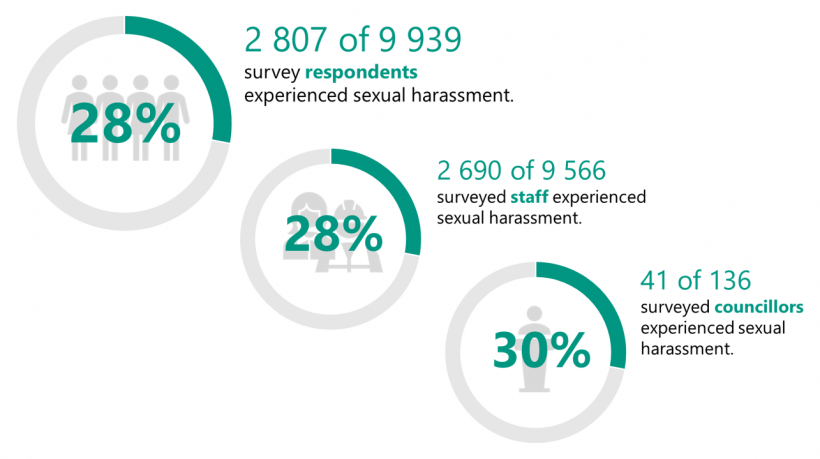
Note: The margin of error for councillors is ±8 per cent. There were 237 respondents who did not outline whether they were staff or councillors. Of these, 76 (32 per cent) experienced sexual harassment.
Source: VAGO LG Survey 2020.
As shown in Figure 2B, we did not find a significant difference in the prevalence of sexual harassment at metropolitan, regional and rural councils. Although individual council results varied, this could be due to differences in response rate. Three quarters of councils had a prevalence rate between 20 and 35 per cent.
FIGURE 2B: Prevalence by council category
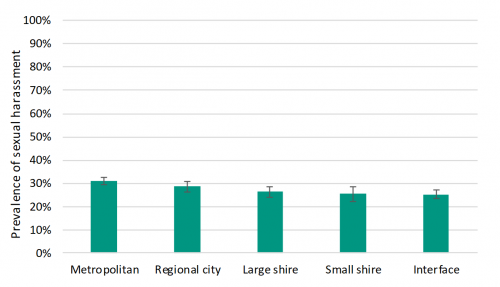
Note: Error bars show the margin of error for each category. See Appendix E for response rates for each category and Appendix F for de-identified individual council results. Interface councils are the municipalities that form a ring around metropolitan Melbourne.
Source: VAGO LG Survey 2020.
Understanding survey results
Although survey data is our best source for understanding the prevalence of sexual harassment, it is dependent on response rates. People who have experienced it may be more likely to complete an optional survey on the topic.
One way to account for this is to assume that everyone who did not do the survey did not experience sexual harassment. This is unlikely, but it helps us understand the minimum rate of sexual harassment in the sector. Based on our results and response rate, at least 7 per cent of the local government sector have experienced sexual harassment in the past 12 months, as outlined in Figure 2C.
FIGURE 2C: Survey results in sector-wide context
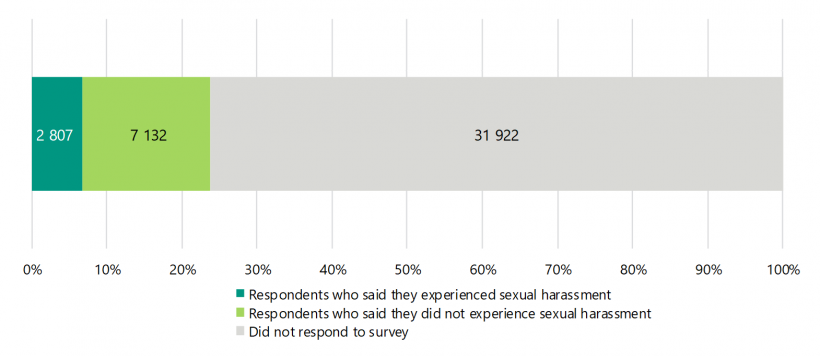
Note: Excludes employees from the four non-participating councils and employees without council email addresses.
Source: VAGO LG Survey 2020.
Prevalence compared to other sectors
Our survey findings indicate that the rate of sexual harassment in local government is similar to comparable sectors, as outlined in Figure 2D.
FIGURE 2D: Prevalence of sexual harassment in workforce surveys
| Sector | Year of survey | Survey specific to sexual harassment? | Prevalence of sexual harassment |
|---|---|---|---|
| Victorian local councils (VAGO LG Survey 2020) | 2020 | Yes | 28% |
| Victorian public sector (PMS) | 2019 | No | 7% |
| Victorian public sector (VAGO VPS Survey 2019) | 2019 | Yes | 29% |
| Public administration and safety (AHRC) | 2018 | Yes | 33% |
| Retail trade (AHRC) | 2018 | Yes | 42% |
| All sectors (AHRC) | 2018 | Yes | 33% |
Note: PMS and VAGO VPS Survey 2019 results refer to departmental staff only; VPS = Victorian Public Service. AHRC survey results cover a five-year period.
Source: VAGO LG Survey 2020; VPSC PMS Survey 2019; VAGO Survey 2019; AHRC National Survey 2018. See Appendix E for more detail on these surveys.
Comparing the prevalence of sexual harassment across sectors is hard because sample size, design and response rates can impact the results. The 2019 PMS found that 7 per cent of employees in Victorian public sector departments had experienced sexual harassment, which is much lower than our results. However, the PMS is broader than our survey, asking employees about a range of workplace issues as well as sexual harassment. This means there is less risk that the results over-represent the experience of sexual harassment.
VAGO also surveyed Victorian public sector employees in 2019, asking only about experiences of sexual harassment. This found that 29 per cent of surveyed employees had experienced sexual harassment in the previous 12 months. Our survey of local councils had a similar response rate and survey design, indicating that the prevalence of sexual harassment in local councils is similar to the Victorian public sector.
2.2 Experiences of sexual harassment
As shown in Figure 2E, the three most common types of sexual harassment experienced by respondents were:
- intrusive questions about their personal life or appearance
- sexually suggestive comments or jokes
- inappropriate staring or leering.
The AHRC National Survey 2018 also found these were the three most common types of workplace sexual harassment.
FIGURE 2E: Types of sexual harassment experienced by VAGO LG Survey 2020 respondents
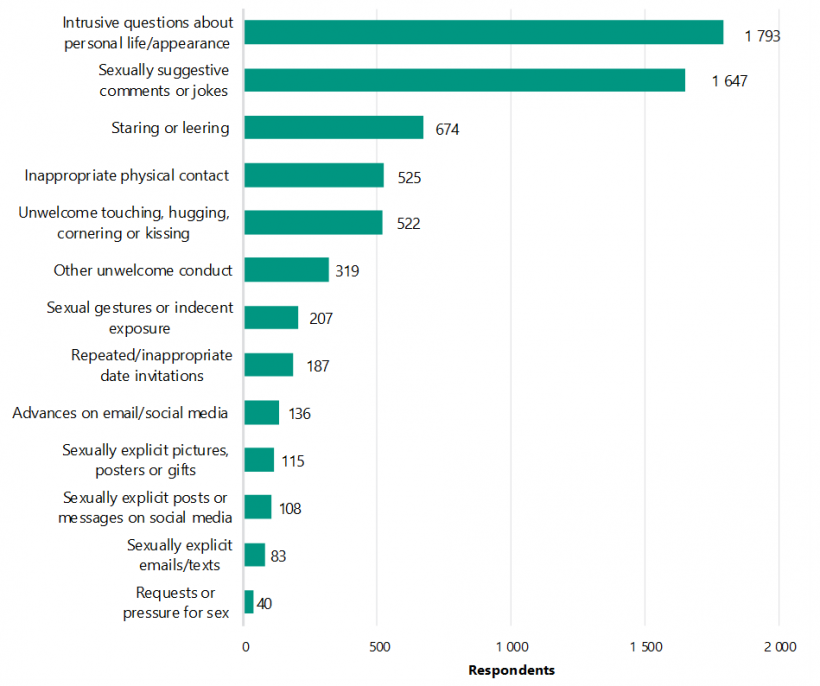
Note: 2 807 respondents said they had experienced at least one of these behaviours at least once in the last 12 months. Respondents could select more than one option.
Source: VAGO LG Survey 2020.
As shown in Figure 2F, most sexual harassment occurred during day-to-day work.
FIGURE 2F: Where did the sexual harassment occur?
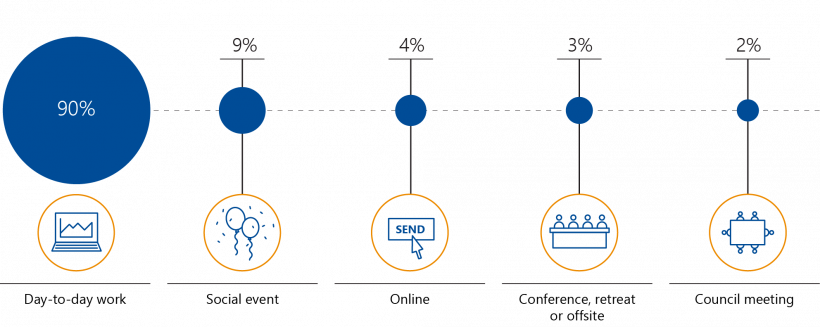
Note: Results shown as percentage of respondents who experienced sexual harassment (2 807). Results do not total 100 per cent because respondents could select more than one answer.
Source: VAGO LG Survey 2020.
Figure 2G shows that the harasser was most likely to be a co-worker at the same level or a more senior co-worker.
FIGURE 2G: What best describes your workplace relationship with the person who sexually harassed you?
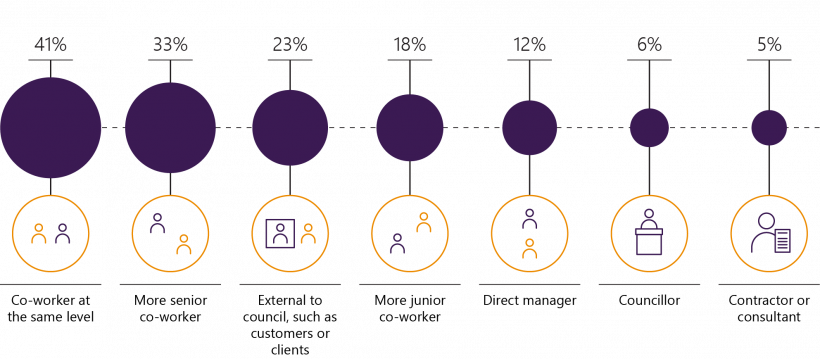
Note: Results shown as percentage of respondents who experienced sexual harassment (2 807). Results do not total 100 per cent because respondents could select more than one answer.
Source: VAGO LG Survey 2020.
Impacts of harassment
![]() I left a fantastic position with higher pay and views of promotion for a lower paid position in a council far from home.
I left a fantastic position with higher pay and views of promotion for a lower paid position in a council far from home.
—Survey respondent
![]() It made me feel like my work was not valued and was not important.
It made me feel like my work was not valued and was not important.
—Survey respondent
![]() It makes me hesitate to take meetings alone.
It makes me hesitate to take meetings alone.
—Survey respondent
![]() Incredibly disappointing. I don't want to work with someone like that. The joy goes out of the job.
Incredibly disappointing. I don't want to work with someone like that. The joy goes out of the job.
—Survey respondent
Regardless of the type or context, sexual harassment can have harmful impacts on those who experience it. Forty-five per cent of respondents who experienced sexual harassment said they were negatively impacted. Figure 2H shows the type of impact respondents said they experienced.
FIGURE 2H: Impacts of harassment
| Impact | Percentage (%) |
|---|---|
| Impact on mental health | 25 |
| Lowered self-esteem and confidence | 21 |
| Impact on employment, career or work | 4 |
| Deterioration of relationships with partner, family and/or friends | 2 |
| Financial loss | 1 |
Note: Results are shown as a percentage of respondents who said they experienced sexual harassment (2 807). Fifty-five per cent of respondents said that it had no impact. Results in table do not add up to 45 per cent because respondents could select more than one answer.
Source: VAGO LG Survey 2020.
Sexual harassment also affects employees' relationships with their council. Some survey respondents said that their experiences:
- worsened their working relationships
- made them lose respect for their colleagues and their council
- lowered their trust in the management at the council.
2.3 Risk factors
Anyone can experience sexual harassment, but some people are at a higher risk. Councils should use this information to better target strategies and communication so that they can give the right level of support to staff and councillors.
The margin of error for people with disability is ±7 per cent and the margin of error for Aboriginal and Torres Strait Islander respondents is ±14 per cent
|
Respondents who… |
experienced sexual harassment at a rate of … |
compared to… |
|
identify as LGBTQIA+ |
48 per cent |
27 per cent of respondents who did not identify as LGBTQIA+ |
|
have disability |
41 per cent |
28 per cent of respondents without disability |
|
are aged 18 to 34 |
38 per cent |
26 per cent of respondents aged 35 or over |
|
are Aboriginal and Torres Strait Islander people |
37 per cent |
28 per cent of non-Aboriginal and Torres Strait Islander people |
|
are women |
30 per cent |
25 per cent of male respondents |
Gender and sexuality
FIGURE 2I: Age and gender
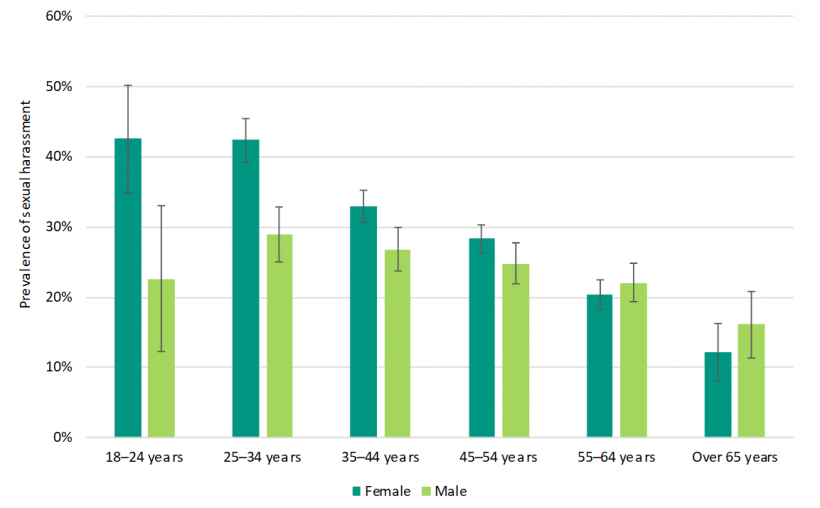
Note: 9 800 respondents identified as either male or female. Error bars show the margin of error for each cohort.
Source: VAGO LG Survey 2020.
Women were also more likely to suffer negative consequences from sexual harassment compared with men. Forty-nine per cent of women who experienced sexual harassment said it had an impact on them, compared to 33 per cent of men.
![]() Does anyone really think that a young female like myself feels comfortable telling my team about it? Especially when my team has often talked about how young people these days are sensitive, and about how women are emotional and can't do certain things.
Does anyone really think that a young female like myself feels comfortable telling my team about it? Especially when my team has often talked about how young people these days are sensitive, and about how women are emotional and can't do certain things.
—Survey respondent
![]() Another manager has made comments about childcare and that women should just stay home and then we wouldn't need to run childcare.
Another manager has made comments about childcare and that women should just stay home and then we wouldn't need to run childcare.
—Survey respondent
![]() [I was] assaulted by a member of the public and called a [homophobic slur]. In front of the team leader and a new employee, my manager laughed as he said, “How did he know?”.
[I was] assaulted by a member of the public and called a [homophobic slur]. In front of the team leader and a new employee, my manager laughed as he said, “How did he know?”.
—Survey respondent
The AHRC National Survey 2018 found that women are at a higher risk of sexual harassment at work. This is true for local government as well. As shown in Figure 2I, our survey found young women experienced sexual harassment at a greater rate than older and male employees. For respondents over the age of 44, there was no statistically significant difference between prevalence for women and men. We received too few responses from respondents with a self-described gender identity to report on levels of harassment for that cohort.
The higher rate experienced by young women reflects the gendered nature of sexual harassment. The VEOHRC Guideline notes that gender inequality is a primary driver of workplace sexual harassment. It creates stereotypes about how women and men should behave that can:
- permit sexist or demeaning language
- make women more vulnerable to harassment
- present a barrier to reporting.
One marker of gender inequality in the workplace is low numbers of women in senior leadership positions compared to men. According to MAV, in 2019, women made up 60 per cent of local government employees but only 40 per cent of organisational leaders. Only one sixth of local council CEOs were women. From March 2021, councils will be required to report on the gender make-up of all levels of the workplace and work to improve gender equality under the Gender Equality Act 2020.
Gender inequality and stereotypes can also put LGBTQIA+ individuals at higher risk of sexual harassment. Our survey found that almost half of all LGBTQIA+ respondents had experienced sexual harassment in the last 12 months. The VEOHRC Guideline notes that this harassment can stem from homophobic, transphobic or hyper masculine work environments.
2.4 Sexual harassment from the public
Sexual harassment from members of the public—such as customers, clients or patients—is a significant risk for councils. Figure 2J shows that harassment from the public happens for all groups, but employees in customer-facing roles are at the greatest risk.
FIGURE 2J: Sexual harassment from members of the public
| Role of person experiencing harassment | Results (%) |
|---|---|
| Customer-facing role | 45 |
| Councillor | 34 |
| Outdoor worker | 27 |
| Office/administration | 13 |
Note: Results are shown as a percentage of respondents who experienced sexual harassment (2 807). Respondents could select more than one option. Because there are fewer councillors than staff, the margin of error for councillors is ±8 per cent.
Source: VAGO LG Survey 2020.
Sexual harassment from the public occurs in a variety of contexts, including in aged care, leisure centres and libraries. Survey respondents highlighted that councils do not always take this type of harassment seriously, and that there is a culture of accepting harassment from the public as part of the job.
FIGURE 2K: Sexual harassment from members of the public
![]() I was shown pornographic images by a customer after he placed his mobile phone down his pants, took a photo of his penis then displayed the image to me which I did not solicit. I was working in isolation at the time and there were two other males with him. When I reported it to my team leader his exact words were ... ’don't think I'm going to report this to the police'.
I was shown pornographic images by a customer after he placed his mobile phone down his pants, took a photo of his penis then displayed the image to me which I did not solicit. I was working in isolation at the time and there were two other males with him. When I reported it to my team leader his exact words were ... ’don't think I'm going to report this to the police'.
—Survey respondent
![]() I spend a lot of time out in public alone conducting inspections. In doing so I am frequently wolf-whistled and glared at and feel extremely vulnerable.
I spend a lot of time out in public alone conducting inspections. In doing so I am frequently wolf-whistled and glared at and feel extremely vulnerable.
—Survey respondent
![]() I have experienced naked people at work and weird sexual comments from patrons. I have reported it in line with council procedures however I received no real debrief or response to the incidents. It seems to be simply seen as something we have to deal with in libraries and not worthy of discussion.
I have experienced naked people at work and weird sexual comments from patrons. I have reported it in line with council procedures however I received no real debrief or response to the incidents. It seems to be simply seen as something we have to deal with in libraries and not worthy of discussion.
—Survey respondent
![]() I have had patrons take photographs of me, make overt sexual comments to me and even touch me, sometimes quite inappropriately … management staff in my sector tend to shrug off any mention of sexual harassment as 'not really that bad' or 'just part of dealing with the public'.
I have had patrons take photographs of me, make overt sexual comments to me and even touch me, sometimes quite inappropriately … management staff in my sector tend to shrug off any mention of sexual harassment as 'not really that bad' or 'just part of dealing with the public'.
—Survey respondent
Note: We have edited quotes for clarity and brevity.
Source: VAGO LG Survey 2020
Councils are legally responsible for providing a safe workplace for employees. This includes addressing the risk of sexual harassment from the public. Under the Equal Opportunity Act 2010 councils must take reasonable and proportionate steps to prevent sexual harassment from occurring.
Except for Ararat, the audited councils could do more to include sexual harassment from third parties in policies and complaint procedures.
|
VEOHRC recommends … |
However … |
|
including sexual harassment by third parties in sexual harassment policies. |
except for Ararat, the audited councils' sexual harassment policies do not cover third parties as potential harassers. |
|
establishing formal procedures, including response actions such as calling the police, or banning a customer from the workplace. |
while the audited councils have formal procedures for dealing with unreasonable customer behaviour, only Ararat’s refers to sexual harassment. |
The audited councils' unreasonable customer procedures focus on loud, rude and violent behaviour. However, as outlined in Section 2.2, the most common types of sexual harassment are not necessarily loud or violent.
As a result, staff may believe that they cannot challenge common forms of sexual harassment from the public because council procedures do not cover them.
Councils should also take proactive measures to prevent sexual harassment from the public, such as:
- putting up signs stating that sexual harassment is unlawful and will not be tolerated
- providing training to staff on dealing with members of the public
- ensuring customer-facing staff know they can refuse service if they feel uncomfortable or unsafe.
2.5 Councillors and sexual harassment
![]() I have seen the rape threats and threatened violence against female councillors and I believe that this prevents women going into or staying in these roles.
I have seen the rape threats and threatened violence against female councillors and I believe that this prevents women going into or staying in these roles.
—Survey respondent
![]() As a female councillor … I have experienced sexual harassment from residents and sexist comments, rather than council employees. There are not any measures to help in this example.
As a female councillor … I have experienced sexual harassment from residents and sexist comments, rather than council employees. There are not any measures to help in this example.
—Survey respondent
![]() I will distance myself from local government and never run for election again.
I will distance myself from local government and never run for election again.
—Survey respondent
Forty-one councillors across the state, or 30 per cent of councillor respondents, said they had been harassed at work in the last 12 months. Although they experienced sexual harassment at a similar rate to council employees, Figure 2L shows that the context of this harassment was different.
In February 2019, the Victorian branch of ALGWA made a submission to the AHRC National Inquiry. The submission highlighted that female councillors were at risk of sexual harassment from constituents, council staff and fellow councillors, including those from other municipalities.
FIGURE 2L: Context of sexual harassment—councillors and staff
| Harassment occurred | Councillors (%) | Staff (%) |
|---|---|---|
| by a councillor | 71 | 5 |
| during a council meeting | 37 | 2 |
| by a member of the public | 34 | 22 |
Note: Results shown as percentage of respondents who experienced sexual harassment (41 councillors and 2 690 staff). Excludes respondents who preferred not to say their role at council. The margin of error for councillors is ±8 per cent.
Source: VAGO LG Survey 2020.
Sexual harassment of councillors can contribute to a culture where women may not feel respected and safe. Forty-four per cent of female councillors, compared to 19 per cent of male councillors, reported experiencing sexual harassment. This is a wider gap in prevalence than for employees.
Higher rates of sexual harassment for female councillors present a challenge to addressing their under-representation on local councils. The Victorian Government's Victorian Gender Equality Strategy aims to achieve equal gender representation on local councils by 2025. In the 2016 council elections, only 38 per cent of elected councillors were women, and 13 municipalities elected just one female councillor. This increased to 44 per cent in the October 2020 elections.
Councillors' positions as elected officials mean they face different barriers to reporting sexual harassment, which we discuss further in Section 4.1.
Councillors and staff
Across the sector, 132 surveyed employees said that a councillor had sexually harassed them in the last 12 months. Survey respondents told us that the power dynamic between staff and councillors makes it difficult to report sexual harassment.
FIGURE 2M: Power dynamic between councillors and staff
![]() One councillor greeted women in council by kissing them on the lips … Why would he think this is acceptable? Female council staff were obviously repulsed but could not say anything.
One councillor greeted women in council by kissing them on the lips … Why would he think this is acceptable? Female council staff were obviously repulsed but could not say anything.
—Survey respondent
![]() A certain councillor used to come in and would make very loud comments about my appearance, and call me things like ‘hot stuff’ … it was hard when I was in the infancy of my career and it is difficult to be respected outright as you are bottom of the food chain.
A certain councillor used to come in and would make very loud comments about my appearance, and call me things like ‘hot stuff’ … it was hard when I was in the infancy of my career and it is difficult to be respected outright as you are bottom of the food chain.
—Survey respondent
![]() In a previous Council I was in a position where a councillor crossed the line, CEO was advised of the incident but I don’t believe it was raised [with council] as CEO’s contract was up for renewal.
In a previous Council I was in a position where a councillor crossed the line, CEO was advised of the incident but I don’t believe it was raised [with council] as CEO’s contract was up for renewal.
—Survey respondent
![]() Often, with older male councillors, casual innuendo and uninvited touching is tolerated and seems harder to enforce from a conduct point of view within the organisation.
Often, with older male councillors, casual innuendo and uninvited touching is tolerated and seems harder to enforce from a conduct point of view within the organisation.
—Survey respondent
Note: We have edited quotes for clarity and brevity.
Source: VAGO LG Survey 2020.
Of the audited councils, only Ararat and Corangamite Shire Council (Corangamite) have sexual harassment policies that explicitly apply to councillors. As the other three councils’ policies do not refer to councillors, staff may not know if or how they can report harassment from a councillor.
2.6 Collecting information about sexual harassment
To prevent sexual harassment, councils first need to understand how common it is and what is driving it in their workplaces. VEOHRC recommends employers carry out anonymous surveys or review exit interviews to gather this information.
Understanding prevalence at a council level
The audited councils do not commonly use workplace surveys to identify rates of sexual harassment. Although all have conducted at least one workplace survey in the last five years, only Frankston City Council (Frankston) asked employees about sexual harassment.
In a 2020 survey, Frankston asked employees whether they agreed that their workplace was free from sexual harassment and gender-based discrimination. Eighty nine per cent of staff agreed. However, the survey did not ask whether employees had experienced sexual harassment. As a result, it does not tell Frankston how common sexual harassment is, and who is most at risk.
In addition, none of the councils categorise complaints in a way that allows them to identify trends in sexual harassment, which we discuss further in Section 4.3.
Understanding the prevalence of sexual harassment will also help councils to meet the requirements of the Gender Equality Act 2020. From June 2021, councils must measure and report on seven gender equality indicators every two years. One of these indicators is the prevalence of workplace sexual harassment.
Understanding prevalence across the sector
Prior to our survey, there was no sector-wide survey in the local government sector about cultural or workforce issues. None of the state agencies or peak bodies overseeing councils run surveys or collect comparative information about sexual harassment or workplace conduct.
Coupled with a lack of workplace surveys at individual councils, it means that the sector has no visibility of the sexual harassment that occurs in its workplaces. Sector wide data on sexual harassment would allow councils to:
- understand the prevalence of sexual harassment and how well they are preventing and responding to it
- benchmark their performance against other councils
- track performance over time.
3. Preventing sexual harassment
Conclusion
Councils are not doing enough to fulfil their positive duty to prevent sexual harassment. Although all audited councils have relevant policies and training, they are not comprehensive enough to be effective.
Audited councils' policies cover broader workplace issues and consequently lack elements that are unique to sexual harassment. Councils also mostly deliver their training through online modules, missing the opportunity to meaningfully engage with staff and challenge outdated views. Across the sector, training misses key groups, including councillors and casual employees.
Council leaders do not regularly promote a culture of respect that does not tolerate sexual harassment. This further undermines the effectiveness of policies and training and leads to reduced employee trust.
This chapter discusses:
3.1 Sexual harassment policies
A comprehensive sexual harassment policy helps employees understand what sexual harassment is, and where to get help if they witness or experience it.
Adequacy of policies
When we began our audit, none of the audited councils had a standalone sexual harassment policy. Instead, they included their policies and procedures on sexual harassment within broader documents about bullying, appropriate workplace behaviour and discrimination.
Except for Ararat, audited councils’ policies lack at least one key element from the model policy.
|
Of the audited councils … |
As a result, there is a risk that … |
|
only Ararat outlines that their sexual harassment policy also applies to online interactions. |
victims of online harassment at the other councils may not know that they are able to use council complaint processes. |
|
Frankston, Latrobe City Council (Latrobe) and Moreland City Council (Moreland) do not explain that sexual harassment is unlawful under the Equal Opportunity Act 2010 in their policy. |
employees may not be aware that sexual harassment can have legal consequences for the harasser and the council. |
|
Frankston and Latrobe's policies do not clearly describe formal and informal processes for resolving complaints. |
parties to a complaint do not have clear expectations of how the council will handle it. Victims or witnesses may not be confident to report sexual harassment. |
|
Frankston lacks a clear policy statement that says that it will not tolerate sexual harassment. |
employees may believe that the council may tolerate some level of sexual harassment and will not treat all complaints seriously. |
|
Corangamite does not provide internal and external support options to victims in its policies. |
victims may not know their support options when they experience sexual harassment. |
In response to this audit, Ararat published a new standalone sexual harassment policy in August 2020 that complies with the model policy.
Accessibility and communication
Policies are only useful if employees and councillors can find them. Councils should ensure their employees can readily access information about how their council prevents and responds to sexual harassment.
Finding sexual harassment policies
Across the sector, 90 per cent of survey respondents said they knew where to find their council's policy on sexual harassment.
All audited councils make their policies accessible:
- on internal networks such as shared drives or intranet pages
- in hard copy at work sites such as depots.
Latrobe, Frankston and Ararat also present their policies in a way that allows a user to search the term ‘sexual harassment’ on the council intranet or file system and find the relevant policy. This makes it easier for staff and councillors to find relevant information.
Except for Frankston, the audited councils spread information on sexual harassment across at least three documents. This increases the risk that staff will not find the right information about their obligations and rights.
Communicating policies
Audited councils do not regularly communicate to staff and councillors about how to find policies on sexual harassment.
Audited councils advised us that their staff learn about policies covering sexual harassment when they commence at the council. Only Frankston routinely communicates to staff and councillors about how and where to find sexual harassment policies. It does this by including information about the policies in its training, which runs every two years. However, as noted in Section 3.2, less than a quarter of survey respondents at Frankston received training at induction.
![]() After our last survey, CEO and other management provided an update that all sexual harassment should be reported. No information was provided about how to report it specifically or the process for how to report it, it was not very reassuring.
After our last survey, CEO and other management provided an update that all sexual harassment should be reported. No information was provided about how to report it specifically or the process for how to report it, it was not very reassuring.
—Survey respondent
![]() The only sexual harassment "training" I was given was an online course I had to do between calls on the job. So it was just another box to tick, and the message I am left with is that council really doesn't take these things very seriously.
The only sexual harassment "training" I was given was an online course I had to do between calls on the job. So it was just another box to tick, and the message I am left with is that council really doesn't take these things very seriously.
—Survey respondent
![]() The mandated annual re-training on sexual harassment is just a tick box exercise that focuses on the extreme physical assaults, not the day-to-day degrading and demeaning behaviours that need to change.
The mandated annual re-training on sexual harassment is just a tick box exercise that focuses on the extreme physical assaults, not the day-to-day degrading and demeaning behaviours that need to change.
—Survey respondent
The 2019 MAV survey found that less than half of surveyed councils actively promote their sexual harassment policies. These results show that a lack of communication about policies is a problem across the sector.
More frequent communication would remind staff of their rights and obligations and ensure they know how to access information to support them if they experience or witness sexual harassment.
3.2 Training on sexual harassment
VEOHRC recommends that organisations take positive steps to train all employees on sexual harassment, including all executives, managers and senior staff, investigators and contact officers.
Reliance on online compliance training
Four of the audited councils include sexual harassment training in a suite of online training modules covering employees' legal rights and obligations. For staff who do not have regular access to council IT platforms, such as staff in depots, these councils provide this training face-to-face. Latrobe provides staff with an online training module on appropriate behaviour, but this does not explicitly refer to sexual harassment.
None of the audited councils deliver in-depth face-to-face training on sexual harassment for all staff. Most staff only ever receive training in an online module format, missing out on the advantages of face-to-face training such as:
- more open discussion about appropriate standards of behaviour in the workplace
- a forum for leaders to reiterate expected values and demonstrate a commitment to preventing sexual harassment.
Online training is common across the sector. In the 2019 MAV survey, 53 per cent of councils said they delivered training specifically on sexual harassment. Forty-six per cent of these councils reported using online training methods. Other councils used internal or external trainers to deliver face-to-face training, such as regional women’s health services or external trainers.
Training does not reach everyone
Twenty-four per cent of survey respondents said they had never received training on appropriate behaviour or sexual harassment at their council. People who were least likely to have received training on appropriate behaviour were:
- new employees
- councillors
- casual employees.
Training for new employees
Figure 3A shows that survey respondents who had been at their council under a year were the least likely to have received training. However, there is still a portion of long term employees who said they had never received training at their current council.
FIGURE 3A: Sexual harassment training by employment length
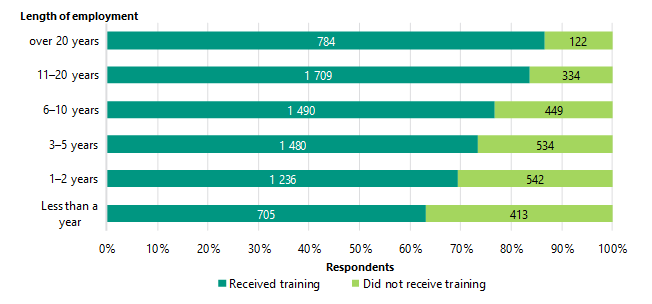
Note: 9 798 people answered how long they have worked at their council and whether they have received training.
Source: VAGO LG Survey 2020.
All five audited councils advised us that new starters must complete their online module on appropriate behaviour. Despite this, less than half of respondents reported receiving appropriate behaviour training at induction, as shown in Figure 3B.
FIGURE 3B: Appropriate behaviour training at induction—audited councils
| Council | Percentage of respondents who completed training at induction (%) |
|---|---|
| Ararat | 36 |
| Corangamite | 46 |
| Frankston | 23 |
| Latrobe | 41 |
| Moreland | 41 |
Source: VAGO LG Survey 2020.
This suggests that new starters either:
- do not receive training on sexual harassment at induction
- do not recall whether training they received as part of induction covered sexual harassment.
Training for councillors
Councillors are not receiving the same amount of training on sexual harassment as employees. Sixty per cent of councillors said they had not received training on sexual harassment or appropriate behaviour from their council. LGV‘s Best practice guide for gender equity in local government recommends councils integrate training in gender equity, unconscious bias and bystander training into councillors' professional development.
The margin of error for councillors' is ±8 per cent.
Except Latrobe, audited councils require councillors to complete online training modules on sexual harassment. However, councils and stakeholders advised us that it is difficult to ensure councillors complete the training, as they are not contracted employees of the council. For example, at one council, only one councillor completed the training in 2018–19.
For councillors elected in the October 2020 elections and those in future years, the Local Government Act 2020 outlines that they must receive induction training within their first six months as councillors. Councils are responsible for developing their own training, but in relation to sexual harassment it must include:
- serious and gross misconduct under the Local Government Act 2020
- gender equality, diversity and inclusiveness
- standards of conduct for councillors, which includes a prohibition on sexual harassment
- the internal arbitration and Councillor Conduct Panel processes (see Section 1.7)
- any practices, protocols or policies in relation to the interaction between members of council staff and councillors.
Training for casual employees
Across employment types, casual employees were the least likely to have received training on sexual harassment. Figure 3C shows that employees on contracts were more likely to have received training than casual staff, but they still received it at a lower rate than ongoing employees.
FIGURE 3C: Training by employment type
| Employment type | Received training at current council (%) |
|---|---|
| Ongoing (full and part-time) | 77 |
| Contract (full and part-time) | 73 |
| Casual | 59 |
Note: Results shown as percentage of council employees who answered question on training. Because we received fewer survey responses from casuals, the margin of error for their result is ±6 per cent. Casuals may have been less likely to do our survey because they have less access to council computers, and because of stand-downs related to COVID-19.
Source: VAGO LG Survey 2020.
Providing training for casual employees at councils is important, because the nature of their employment may make them less likely to make a complaint when sexual harassment occurs. The AHRC National Survey 2018 found young people in casual work in hospitality and retail were less likely to speak up about sexual harassment because of a fear of losing shifts or employment.
In our survey, casual staff reported experiencing sexual harassment at a lower rate than other employees. However, they were more likely to be:
- women, who experience a higher rate of sexual harassment (Section 2.3)
- in customer-facing roles, facing a risk of harassment from the public (Section 2.4).
Ensuring sexual harassment training reaches casual employees can help to address barriers to reporting and ensure they understand their right to a workplace free of sexual harassment.
![]() My personal experience of harassment as a frontline worker included non-consensual touching of my bottom, unwelcome comments and body language and photos stealthily being taken of me without my consent … As I moved into an administrative role it became clear the council has good policies on sexual harassment, but they were not trickling to the frontline workers.
My personal experience of harassment as a frontline worker included non-consensual touching of my bottom, unwelcome comments and body language and photos stealthily being taken of me without my consent … As I moved into an administrative role it became clear the council has good policies on sexual harassment, but they were not trickling to the frontline workers.
—Survey respondent
Monitoring training completion
All audited councils provided training attendance records for their online sexual harassment modules. In line with our survey findings, these demonstrated that not all employees had completed training. However, only Ararat’s and Frankston’s records noted reasons why employees had not done so. For example, Ararat’s record noted where employees had not completed training because they were on parental leave.
More detailed training records would allow councils to monitor who has not completed required training.
Content of training
Training should include enough detail for staff to understand what sexual harassment is and how to respond. Effective training gives employees the skills, knowledge and confidence to apply what they have learnt in the workplace.
Our survey suggests that training at councils covers the key elements necessary for comprehensive training on sexual harassment. Figure 3D shows that 96 per cent of respondents who received training said it covered acceptable standards of behaviour.
FIGURE 3D: Coverage of sexual harassment in training content
| Content | Covered content (%) |
|---|---|
| Acceptable standards of behaviour and what behaviours are inappropriate | 96 |
| Where to seek help or support for myself or co-workers | 90 |
| What I should do If I witness sexual harassment | 88 |
| My council's workplace policy and procedures | 88 |
| Options for reporting sexual harassment | 85 |
Note: Results shown as percentage of respondents who said they had received training at their current council (7 471).
Source: VAGO LG Survey 2020.
However, when we reviewed the training material at audited councils, we found key gaps that make training less comprehensive.
|
Of the five audited councils … |
This is a gap because … |
|
none cover bystander interventions in their appropriate behaviour training. Moreland has a separate training course for bystander interventions. However, this is not compulsory for staff and is not specific to sexual harassment. |
encouraging bystanders to speak up when they hear or see sexual harassment can be a powerful tool in building a positive and safe workplace. |
|
only Frankston tailors training to reflect council policies and procedures. |
training should equip staff to comply with workplace policies and procedures. Tailored training can also provide detail about work settings that are unique to the council or the sector, such as depots and libraries. |
|
Latrobe and Moreland do not provide training for managers on how to respond to complaints of sexual harassment. |
managers play a key role in complaint handling and resolution. Eleven per cent of surveyed managers said they would not feel confident in their ability to respond effectively to a complaint of sexual harassment relating to a staff member they supervised. |
3.3 Leading a culture of respect
Leaders at councils, including CEOs, mayors and councillors, play an important role in creating a respectful workplace that does not tolerate sexual harassment. Comprehensive policies and training are not effective if employees believe council leaders do not actually support them.
Modelling respectful behaviour
Leaders build a culture of respect by modelling respectful behaviour, including calling out inappropriate conduct. Survey respondents gave examples of leaders not modelling respectful behaviour, or failing to call out instances of sexual harassment, making staff lose faith that their council takes harassment seriously.
FIGURE 3E: Leaders not modelling respectful behaviour
![]() I had a manager make inappropriate jokes towards a female colleague during a large meeting. I spoke with them after to let them know how it came across and how it made him look (degrading of women) and he was very apologetic. What concerned me was that his boss made no comment or reaction during the meeting, when it was clear by the murmurs and looks around the room, that most felt it was a joke gone too far.
I had a manager make inappropriate jokes towards a female colleague during a large meeting. I spoke with them after to let them know how it came across and how it made him look (degrading of women) and he was very apologetic. What concerned me was that his boss made no comment or reaction during the meeting, when it was clear by the murmurs and looks around the room, that most felt it was a joke gone too far.
—Survey respondent
![]() I was involved with a conversation which occurred at a manager catch up where the CEO was present. [The conversation was] totally inappropriate and uncomfortable with snickering etc. Not one [executive team] member or CEO said anything.
I was involved with a conversation which occurred at a manager catch up where the CEO was present. [The conversation was] totally inappropriate and uncomfortable with snickering etc. Not one [executive team] member or CEO said anything.
—Survey respondent
![]() I have experienced sexual harassment at another council, where the CEO acted inappropriately to myself and other staff. If the CEO behaves in this way then the tone is set for the rest of the organisation. People are unlikely to report if a decision maker is a perpetrator.
I have experienced sexual harassment at another council, where the CEO acted inappropriately to myself and other staff. If the CEO behaves in this way then the tone is set for the rest of the organisation. People are unlikely to report if a decision maker is a perpetrator.
—Survey respondent
![]() I believe that within my council, there is a councillor who is known to be inappropriate. It seems that this is known about and discussed within leadership. However, as this councillor is still in his role, it leads me to assume that leadership do not take this issue seriously.
I believe that within my council, there is a councillor who is known to be inappropriate. It seems that this is known about and discussed within leadership. However, as this councillor is still in his role, it leads me to assume that leadership do not take this issue seriously.
—Survey respondent
Note: We have edited quotes for clarity and brevity.
Source: VAGO LG Survey 2020.
Conversely, strong leadership can make victims feel supported to make complaints of sexual harassment:
I approached the CEO and informed him of what had happened and was so very grateful to him of his support of me and of pushing human resources team to follow up on investigation with the … allegations. The CEO was very supportive and for that I truly thank him.
—Survey respondent
Communication from leaders
Communication from senior leadership builds awareness of how to report sexual harassment if it occurs. Only 31 per cent of survey respondents said their council communicates to them annually about how they are addressing or preventing sexual harassment.
None of the five audited councils could provide evidence of communication from senior council staff, CEOs or mayors about sexual harassment or appropriate behaviours. However, except Moreland, the councils advised that human resources (HR) representatives send emails to staff about appropriate behaviour prior to staff parties.
Communication prior to social events is useful, as it reiterates to staff that the council expects appropriate workplace behaviour to continue in a social setting. However, communication from leadership should reflect that sexual harassment happens in many different settings. As outlined in Section 2.2, victims of harassment were more likely to experience sexual harassment during their day-to-day work than during social functions.
Staff confidence
Overall, 77 per cent of survey respondents believed their council takes sexual harassment seriously. However, survey respondents were more likely to believe their council takes sexual harassment seriously if:
- their council sent annual communications about how it addresses sexual harassment (94 per cent)
- they received training at their current council (83 per cent)
- they agreed their council communicated a message of zero tolerance (88 per cent).
3.4 Addressing resistance and backlash
Organisations can face resistance or backlash from staff when acting to prevent sexual harassment. Examples of resistance include:
- denying sexual harassment exists
- undermining, bullying, or punishing people who raise concerns about sexual harassment
- disrupting training sessions or refusing to take part
- openly challenging workplace policies and complaint processes.
We found that 9 per cent of respondents did not consider the behaviours listed in Figure 2E in Section 2.2 to be sexual harassment. Thirteen per cent said they considered some of the behaviours, but not all, sexual harassment.
In addition, some survey respondents expressed views that excused or trivialised sexual harassment or described victims as being too sensitive.
FIGURE 3F: Resistance and backlash
![]() Only ladies should be worried about sexual harassment … Ladies should behave themselves [with] propriety to avoid sexual harassment … Ladies should be dressed [with] propriety to avoid sexual harassment.
Only ladies should be worried about sexual harassment … Ladies should behave themselves [with] propriety to avoid sexual harassment … Ladies should be dressed [with] propriety to avoid sexual harassment.
—Survey respondent
![]() Easiest way to avoid these issues is to basically refuse to work with anyone of the opposite gender in close proximity, alone with them without a third party present or have anything to do with them outside of work.
Easiest way to avoid these issues is to basically refuse to work with anyone of the opposite gender in close proximity, alone with them without a third party present or have anything to do with them outside of work.
—Survey respondent
![]() At the end of the day, if you get offended, it is up to you to do something about it, people need to take personal responsibility and be an adult, not cry in the corner and expect outside organisations or their employer to anticipate their woes.
At the end of the day, if you get offended, it is up to you to do something about it, people need to take personal responsibility and be an adult, not cry in the corner and expect outside organisations or their employer to anticipate their woes.
—Survey respondent
![]() The fact is, that the ability for men and women to simply 'get along together harmoniously' was so much better in the past, before the 'serially offended' popped up.
The fact is, that the ability for men and women to simply 'get along together harmoniously' was so much better in the past, before the 'serially offended' popped up.
—Survey respondent
Note: We have edited quotes for clarity and brevity.
Source: VAGO LG Survey 2020.
These responses highlight the importance of regular training and communication from senior leadership. As outlined in Sections 3.2 and 3.3, the audited councils do not provide in-depth training or regularly communicate about sexual harassment. This makes it difficult for them to:
- understand the level of resistance or backlash among staff
- create opportunities for safe and open dialogue
- educate staff and councillors about sexual harassment
- counter myths or stereotypes about sexual harassment.
4. Responding to sexual harassment
Conclusion
Councils do not always support and encourage staff to report their experiences of sexual harassment. Although they offer formal and informal complaint options, victims rarely use them.
When victims do speak out, councils do not always handle their complaints fairly or effectively. For instance, we found examples of councils excusing inappropriate behaviour when staff raised concerns about it. This reduces staff confidence in complaint handling and makes it challenging for victims to report their experiences.
Audited councils lacked full complaint documentation and failed to record why they had stopped investigating some complaints. This sends a message to victims that councils do not take their experiences seriously. It also puts councils at risk if employees challenge their decisions.
This chapter discusses:
4.1 Encouraging complaints
Employers must support victims to make complaints of sexual harassment and ensure staff know how and where to make a complaint.
Barriers to making complaints
Of survey respondents who experienced sexual harassment, only:
- 2 per cent made a formal complaint to their council
- 10 per cent told their manager
- 19 per cent told a colleague.
We asked respondents who experienced sexual harassment why they did not make a formal complaint. Figure 4A shows their responses.
FIGURE 4A: Top reasons for not making a formal complaint
| Reason | Percentage of respondents (%) |
|---|---|
| Did not think the behaviour was serious enough | 60 |
| Did not think it would make a difference | 25 |
| Believed there would be negative consequences for their reputation or career | 24 |
| Did not need to, because the harassment stopped | 14 |
| Thought the complaint process would be embarrassing or difficult | 13 |
Note: Respondents shown as percentage of those who experienced sexual harassment who did not make a formal complaint (2 753). Results do not total 100 per cent because respondents could select more than one option.
Source: VAGO LG Survey 2020.
![]() He was in a director’s position, therefore I didn’t report the numerous verbal advances he was making due to being fearful of not being believed by management and/or potentially losing my job.
He was in a director’s position, therefore I didn’t report the numerous verbal advances he was making due to being fearful of not being believed by management and/or potentially losing my job.
—Survey respondent
![]() No one wanted to report him because he was our manager and there were fears of reprisals if he kept his job. Also there was no middle ground for reporting, it was either a formal complaint/process or nothing.
No one wanted to report him because he was our manager and there were fears of reprisals if he kept his job. Also there was no middle ground for reporting, it was either a formal complaint/process or nothing.
—Survey respondent
The most common reason respondents gave for not making a complaint is that they did not think the behaviour was serious enough. However, sexual harassment does not need to be physical, or a criminal offence, to have negative impacts on individuals. In addition, the impacts of frequent low-level sexual harassment can build up over time and make employees feel unsafe at work.
Some respondents told us they were unsure if the unwanted behaviour was serious enough to be considered sexual harassment. This demonstrates the importance of:
- comprehensive training to educate staff on what is and is not sexual harassment (Section 3.2)
- communication from senior leadership that no form of sexual harassment is tolerated (Section 3.3)
- ensuring there are a range of complaint options to suit all forms of harassment (Figure 4B).
Complaint pathways
Coming forward with a complaint of sexual harassment, as a victim or a bystander, can be challenging. The VEOHRC Guideline outlines that organisations should allow for different reporting options, giving complainants the flexibility to choose the pathway that is right for them. Figure 4B outlines five main pathways.
FIGURE 4B: Complaint pathways
| Complaint pathway | Description | Advantages | Disadvantages |
|---|---|---|---|
| Self-managed | Complainant is supported to resolve the matter on their own, for example, by raising the issue with the other person and asking them to change their behaviour. |
|
|
| Anonymous | Complainant advises council of incident(s) of sexual harassment without identifying themselves. |
|
|
| Informal | Parties resolve the issue internally, without a formal investigation. For example, a manager speaks to the person to raise concerns about their behaviour or facilitates a mediation. |
|
|
| Formal | Dealing with a matter using formal internal processes, with documented investigation. |
|
|
| External | Referring the matter to an external body such as VEOHRC or Victoria Police. |
|
|
Source: VAGO, based on VEOHRC Guideline.
Self-managed complaints
Across the sector, respondents were most likely to use self-managed complaint pathways. Twenty-four per cent of respondents who experienced sexual harassment said they told the person the behaviour was not okay. However, power dynamics mean this pathway is not equally accessible to all employees. As outlined in Figure 4C, younger respondents were less likely to respond to harassment this way.
FIGURE 4C: Respondents who experienced sexual harassment who self-managed their complaint by age group
![]() The harassment had been noticed by many of my colleagues but I laughed it off because I found it humiliating, and I just wanted it to stop. I was also disappointed in myself for not calling it out, but it was always with an audience, and I just found it so embarrassing and I didn’t want to draw any attention to it.
The harassment had been noticed by many of my colleagues but I laughed it off because I found it humiliating, and I just wanted it to stop. I was also disappointed in myself for not calling it out, but it was always with an audience, and I just found it so embarrassing and I didn’t want to draw any attention to it.
—Survey respondent
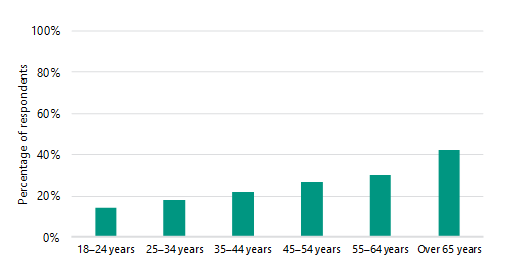
Note: Results shown as percentage of respondents who experienced sexual harassment and provided their age (2 778). Results are comparative for each group, so do not add up to 100 per cent. Self-managed refers to respondents who reacted to experience of sexual harassment by telling the person the behaviour was not okay.
Source: VAGO LG Survey 2020.
Anonymous complaint channels at audited councils
All five audited councils have informal and formal pathways for sexual harassment complaints, allowing complainants to choose the option that suits them. When we began this audit, none allowed for anonymous complaints.
Although anonymous complaints make a proper investigation unlikely, they can:
- encourage complaints from employees who may not feel comfortable coming forward
- provide an avenue for staff to raise lower-level issues they consider not serious enough for a formal complaint.
As outlined in Figure 4A, 60 per cent of respondents did not think the sexual harassment they experienced was serious enough to make a complaint. Almost one quarter of respondents who did not make a complaint said it was because they were worried about negative consequences for their reputation or career.
Anonymous complaint channels can also provide useful insights on cultural and behavioural issues. In the absence of these channels, staff surveys can provide this insight. However, as discussed in Section 2.6, only Frankston uses staff surveys to ask about sexual harassment.
In response to this audit, Ararat reviewed its Staff Grievances Policy in August 2020 to allow for anonymous complaints.
Complaint pathways for councillors
![]() The process to stop bullying and harassment is too hard. … Then people wonder why women do not have equal representation in politics. It's because they are sexually harassed and bullied until they can no longer take it.
The process to stop bullying and harassment is too hard. … Then people wonder why women do not have equal representation in politics. It's because they are sexually harassed and bullied until they can no longer take it.
—Survey respondent
ALGWA’s submission to the AHRC National Inquiry highlighted that barriers to councillors reporting sexual harassment include:
- fear of political retribution or victimisation
- the mayor being the harasser, as the mayor has a mandated role for resolving complaints
- the lack of impartiality in complaints resolution processes when Councillor Codes of Conduct require councillors to first decide among themselves if there has been a breach of the code.
Another barrier is that councillors lack access to the same informal and independent complaint options as staff. This is because dispute resolution processes in Councillor Codes of Conduct are not always appropriate for sexual harassment.
At the time of our audit, at all audited councils except Ararat, councillors had to first attempt to resolve disputes between themselves before accessing formal options. As outlined in Figure 4A, self-management of complaints is inappropriate in some circumstances. Codes of Conduct for the five audited councils also did not outline that, like employees, councillors can make complaints of sexual harassment to external bodies, such as VEOHRC or Victoria Police.
Councillors were also less likely than employees to know how to find support if they experienced sexual harassment. Twenty-nine per cent of surveyed councillors did not know how to access their council's EAP, compared to just 7 per cent of employees.
The margin of error for councillors is ±8 per cent.
The Local Government Act 2020 introduced new requirements for Councillor Codes of Conduct. These changes mean that councillors will not need to attempt to resolve complaints of sexual harassment between themselves. Councillors can refer any alleged breaches of the standards of conduct, including sexual harassment, to an independent arbiter appointed by the Registrar.
Knowledge of how to make a complaint
Complaint pathways are only useful if employees know about them. Sixteen per cent of survey respondents across the sector said they did not know how to make a formal complaint of sexual harassment to their council. Knowledge of complaint pathways was not equal across employees. Respondents were less likely to know how to make a formal complaint if they:
- had never received training from their council (31 per cent did not know)
- were aged under 34 years (30 per cent did not know)
- had experienced sexual harassment (23 per cent did not know).
This highlights the importance of providing training to all staff and councillors and including detailed information about how to make a complaint (see Section 3.2).
4.2 Handling complaints
Consistent and fair handling of sexual harassment complaints is critical to meeting a council's positive duty to eliminate sexual harassment. It also:
- increases employees' faith in the system, in turn encouraging more people to report
- helps prevent matters escalating to legal proceedings.
Of the audited councils, three had at least one documented sexual harassment complaint in the past five years. Each of these had elements of fair and effective complaint handling, including that investigators:
- collected witness statements and evidence where possible
- offered support persons and EAP support to respondents and complainants
- provided respondents with details of allegations in writing
- documented the outcomes of complaints.
However, we found gaps in some complaints that undermined these councils' complaint handling.
|
Gaps |
Examples |
|
Not informing complainants of the outcome of their complaint |
Only Moreland informed complainants of the outcome of their complaint. It was the only audited council to include this step in its complaint-handling procedures. |
|
Minimising sexual harassment or misunderstanding its legal definition |
In one complaint, investigators told a respondent to ‘think about putting [themselves] into a situation where claims like this may be made’. This statement shows bias towards the respondent by suggesting the victim did something to encourage the harassment. In another complaint, investigators described a respondent’s unwanted advance on social media as 'unprofessional, not unlawful' and noted that the behaviour was only a problem if the recipient 'says no and [they] continue.' This is not accurate. Sexual harassment is unlawful under the Equal Opportunity Act 2010 even if it does not amount to a criminal offence, and it does not need to be repeated. |
Using language that excuses or trivialises sexual harassment reduces staff confidence in complaint handling. As outlined in Section 4.1, the second most common reason respondents gave for not making a complaint was that they did not think it would make a difference.
Survey responses from across the sector illustrate that victims can lose faith in their councils when managers or co-workers excuse inappropriate behaviour.
FIGURE 4D: Excusing behaviour
![]() A senior officer made an extremely inappropriate comment and gesture to me that made me feel incredibly uncomfortable … After thinking it through over the following days, I told a few people who all responded, ‘That’s just what he’s like’.
A senior officer made an extremely inappropriate comment and gesture to me that made me feel incredibly uncomfortable … After thinking it through over the following days, I told a few people who all responded, ‘That’s just what he’s like’.
—Survey respondent
![]() I have observed less extreme behaviours being acknowledged but not called out or addressed, for example male councillors calling female staff “dear, sweetie, legs, good lookin’”, touching their back guiding them into rooms. [This is] excused because they are old men from that generation, and they don’t mean anything by it.
I have observed less extreme behaviours being acknowledged but not called out or addressed, for example male councillors calling female staff “dear, sweetie, legs, good lookin’”, touching their back guiding them into rooms. [This is] excused because they are old men from that generation, and they don’t mean anything by it.
—Survey respondent
![]() When I told a work colleague this person had made these comments, they said it was well known that this person talked to women like this and had done so for many years! This doesn’t give you much hope when its well-known and still nothing happens to these offenders.
When I told a work colleague this person had made these comments, they said it was well known that this person talked to women like this and had done so for many years! This doesn’t give you much hope when its well-known and still nothing happens to these offenders.
—Survey respondent
Source: VAGO LG Survey 2020.
Reluctant complainants
As outlined in Section 4.1, a fear of negative consequences is a barrier for victims making complaints. Councils can begin to address this barrier by advising victims that they will support them through a formal complaint process.
In the complaints we reviewed, there was no evidence that audited councils encouraged reluctant complainants to continue with their complaint. In one case, a complainant said they were reluctant to proceed because they ‘did not want to cause any trouble’. Although council HR staff then met with the alleged harasser, there is no evidence that they formally investigated the complaint.
None of the audited councils’ complaint handling procedures consider situations where complainants are reluctant to participate in a formal process. This is partly due to the broadness of their procedures. They apply to a range of inappropriate behaviours, many of which do not have the same barrier to reporting. As part of effective complaint handling, councils should advise all complainants that they have a right to make a formal complaint and that the council will support them to do so.
Criminal matters
Some types of sexual harassment may also be criminal offences, such as stalking, sexual assault and indecent exposure. The VEOHRC Guideline notes that a complainant has the right to decide whether to report criminal behaviour to the police and that employers should support them to do so.
Complaint handling procedures for all audited councils note that councils should refer potential criminal offences to Victoria Police. Moreland's procedure makes this compulsory. For the other four, investigators have discretion over whether to report, but their procedures offer no guidance on how to support victims who are reluctant to pursue their complaint. This is another example where broad inappropriate behaviour policies fail to reflect the different dynamics of sexual harassment.
4.3 Recording complaint information
Councils must keep accurate records of sexual harassment complaints for:
- external reviewers or courts if a party challenges the outcome of a complaint
- compliance with the Public Records Act 1973.
None of the sexual harassment complaints we reviewed at audited councils had complete files. Examples of missing documentation included:
- written responses from respondents
- records of meetings with respondents, including one to caution an employee on their behaviour
- summaries of investigation findings.
Documenting decisions not to investigate
None of the audited councils documented their rationale when they stopped investigating a complaint. This is a critical gap, as it means future reviewers or courts cannot determine if the council’s decision not to investigate was appropriate.
These gaps in documentation also cast doubt over whether audited councils record all the sexual harassment complaints they receive. In one instance, an audited council briefly noted on an employee’s personal development plan that there had been two complaints against the employee. The council later explained to us that the complaints were from members of the public concerned about the employee’s inappropriate behaviour towards women. The council did not record details of these complaints or investigate them.
Systems for recording complaints
Four of the five audited councils have a centralised register for complaints. Corangamite is developing one in response to this audit.
Recording high-level complaint information in a centralised register allows councils to:
- track complaints over time
- identify emerging issues in different units within the council
- address underlying risk factors for sexual harassment
- ensure important information is available for future HR staff.
Even though they had complaint registers, HR departments at audited councils had difficulty providing context for some complaints, because they had not worked at the council when they occurred. Changes in HR staff can lead to a loss of knowledge about the context of past sexual harassment complaints. A more detailed centralised register, along with complete documentation of all complaints, allows HR personnel to understand the history of complaints at the council.
Categorising complaints
Complaint registers are most useful if they categorise complaints according to types of behaviour or misconduct. Without this, it is difficult to use registers to identify trends in workplace behaviour.
Except for Corangamite, the audited councils could not readily quantify the number of sexual harassment complaints they had received over the last five years. For example, Latrobe initially provided us with four complaints, only two of which were for sexual harassment. We later identified a further two complaints of sexual harassment on their register.
Frankston, Latrobe and Moreland categorise complaints in their register, but do not use sexual harassment as a category. Instead, they file complaints of sexual harassment under broader labels such as ‘conduct’ or ‘harassment’.
Although Corangamite did not have a centralised register, HR staff could identify the number of complaints because their department was small and had not changed over the period we examined.
Security of complaint documentation
Complaint documentation contains sensitive and confidential information about employees. We found two instances where audited councils did not keep this documentation secure:
- A previous HR employee at one council stored all complaint documentation on a USB device only, against council record management policy. The employee then took the device with them when they left the council. Although HR staff later retrieved the device, they cannot be certain that the employee did not share or duplicate the information.
- At another council, a 2019 internal audit found that filing cabinets full of employee information were not secure because the HR department kept the keys in a cup in their workspace. In response to the audit, the council provided keys for individual HR employees.
In both instances, the councils identified and corrected issues in information security. However, these examples highlight how individual actions can undermine policies and controls around keeping information confidential.
Appendix A. Submissions and comments
We have consulted with the Department of Jobs, Precincts and Regions, Ararat, Corangamite, Frankston, Latrobe and Moreland, and we considered their views when reaching our audit conclusions. As required by the Audit Act 1994, we gave a draft copy of this report, or relevant extracts, to those agencies and asked for their submissions and comments.
Responsibility for the accuracy, fairness and balance of those comments rests solely with the agency head.
Responses were received as follows:
Response provided by the Associate Secretary, Department of Jobs, Precincts and Regions
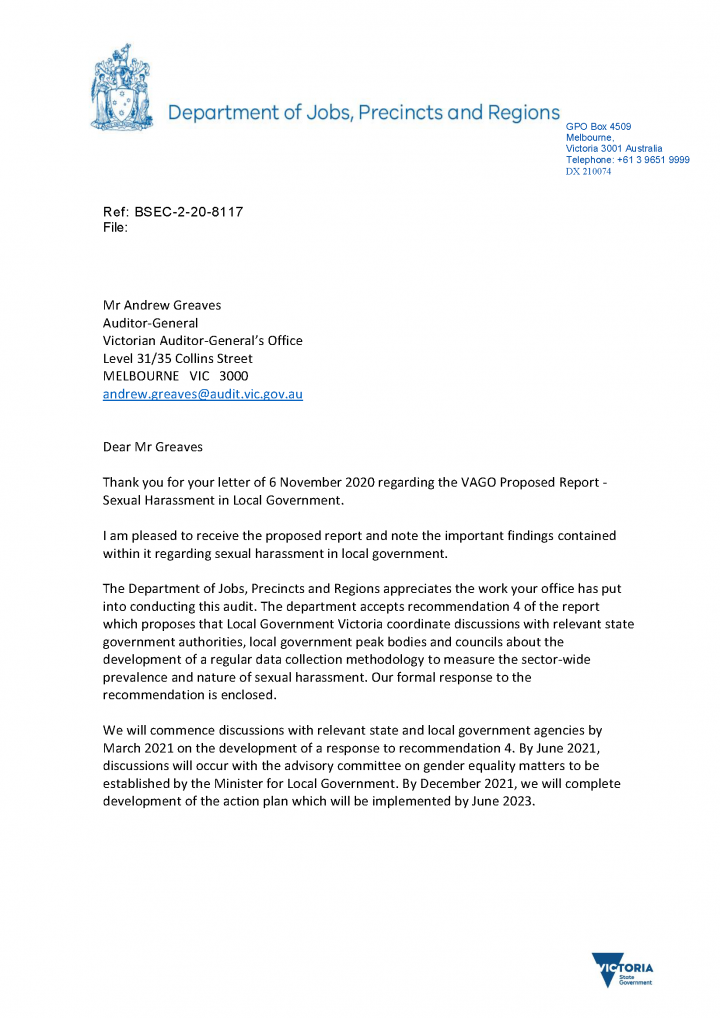
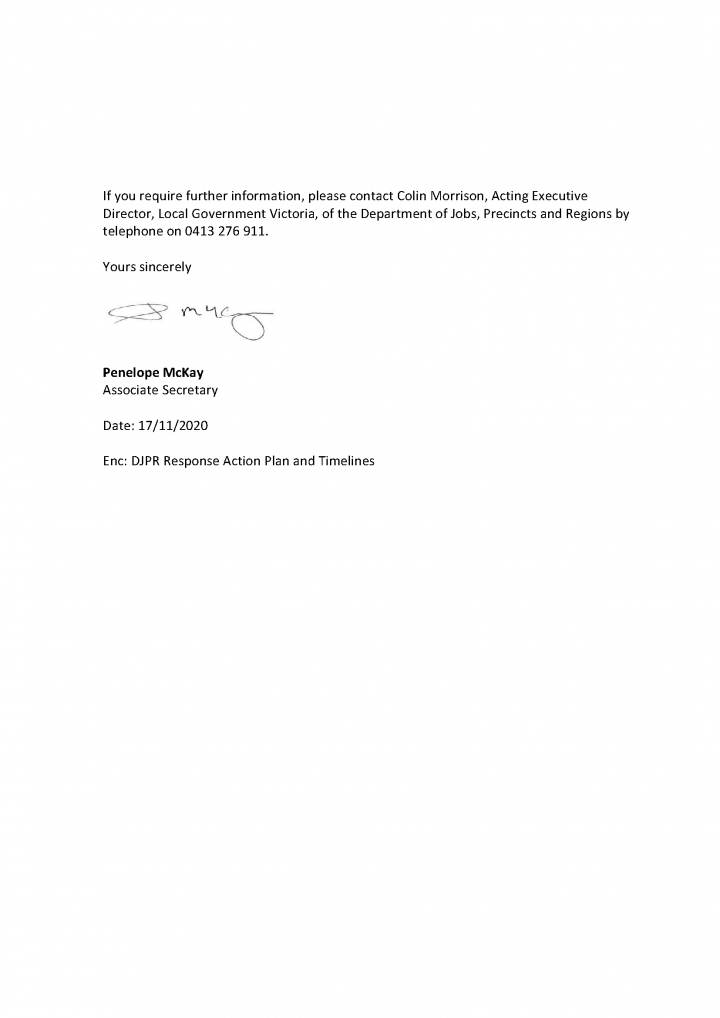
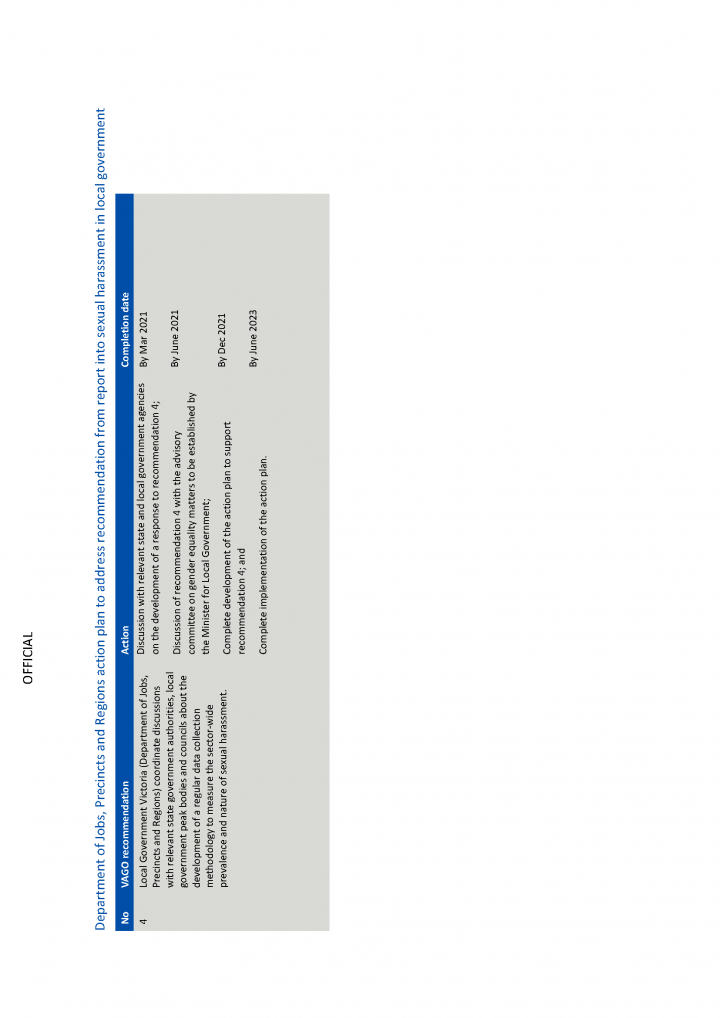
Response provided by the Chief Executive Officer, Ararat
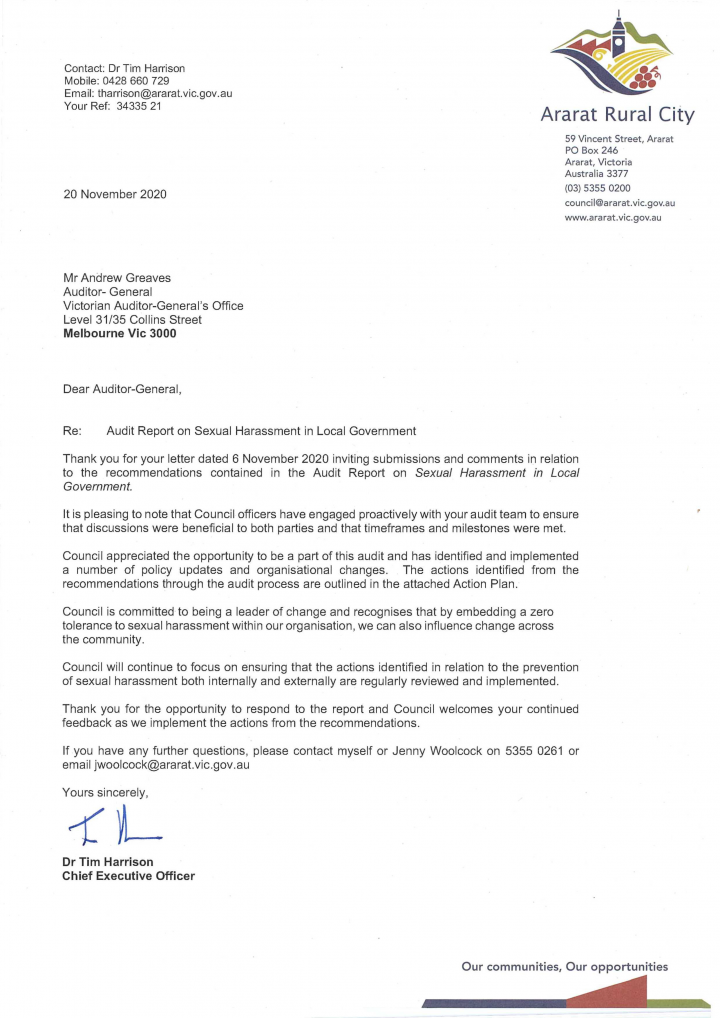
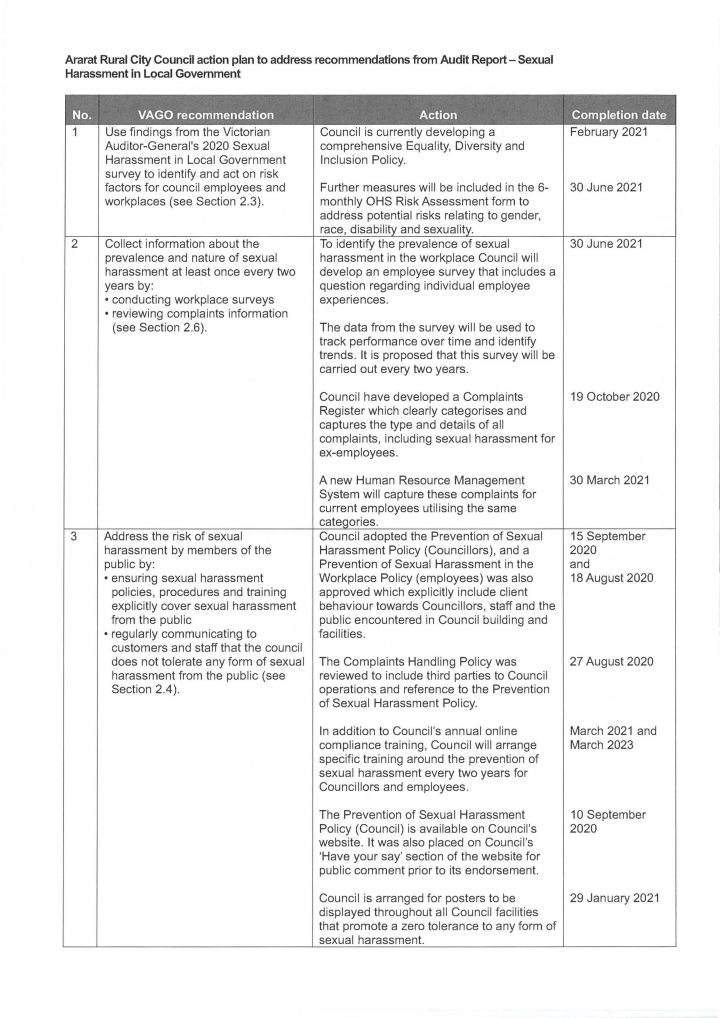
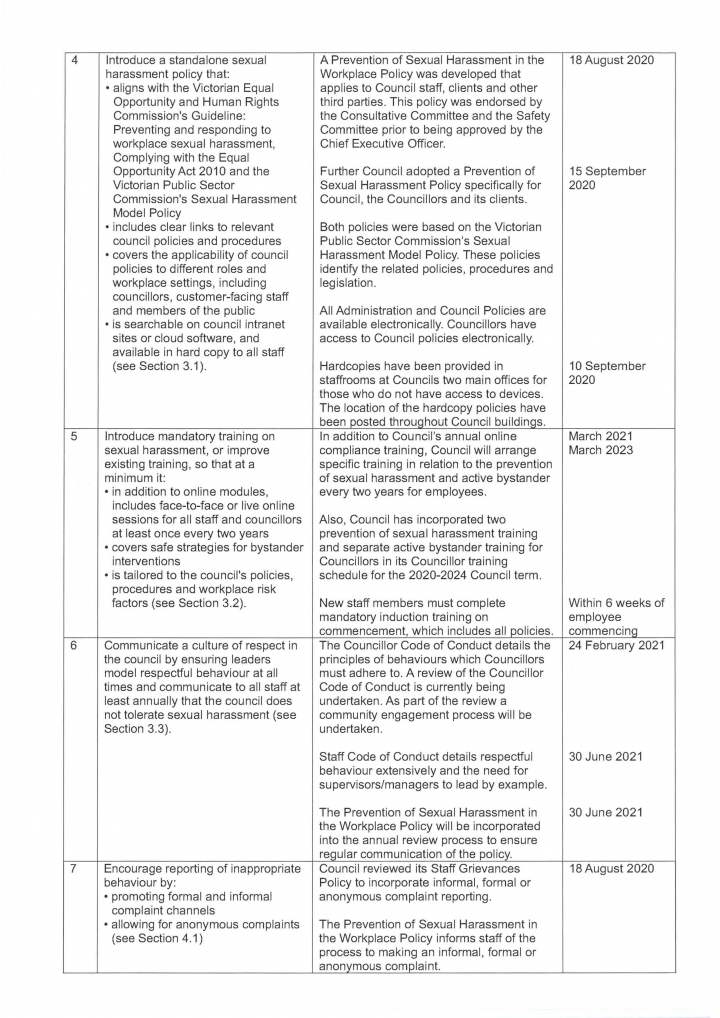
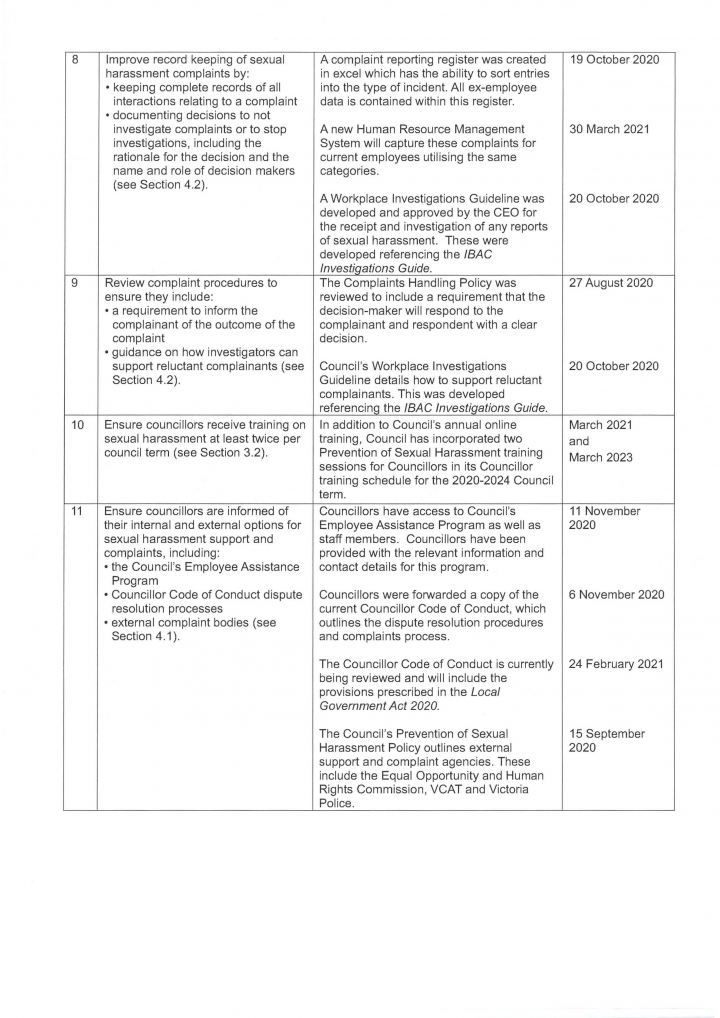
Response provided by the Chief Executive Officer, Corangamite
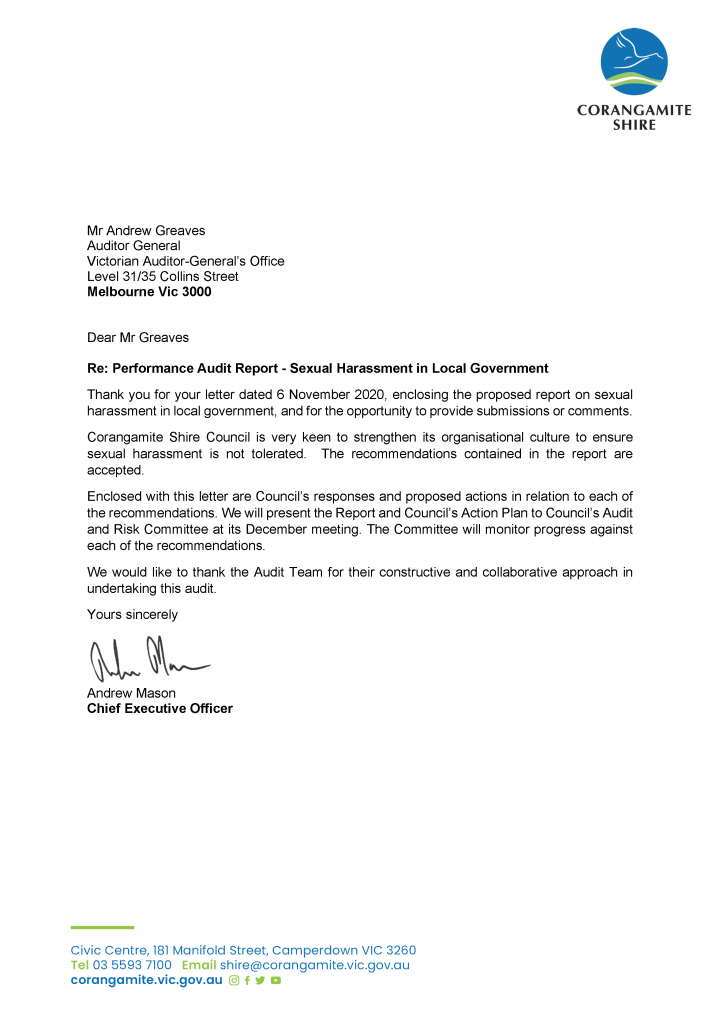
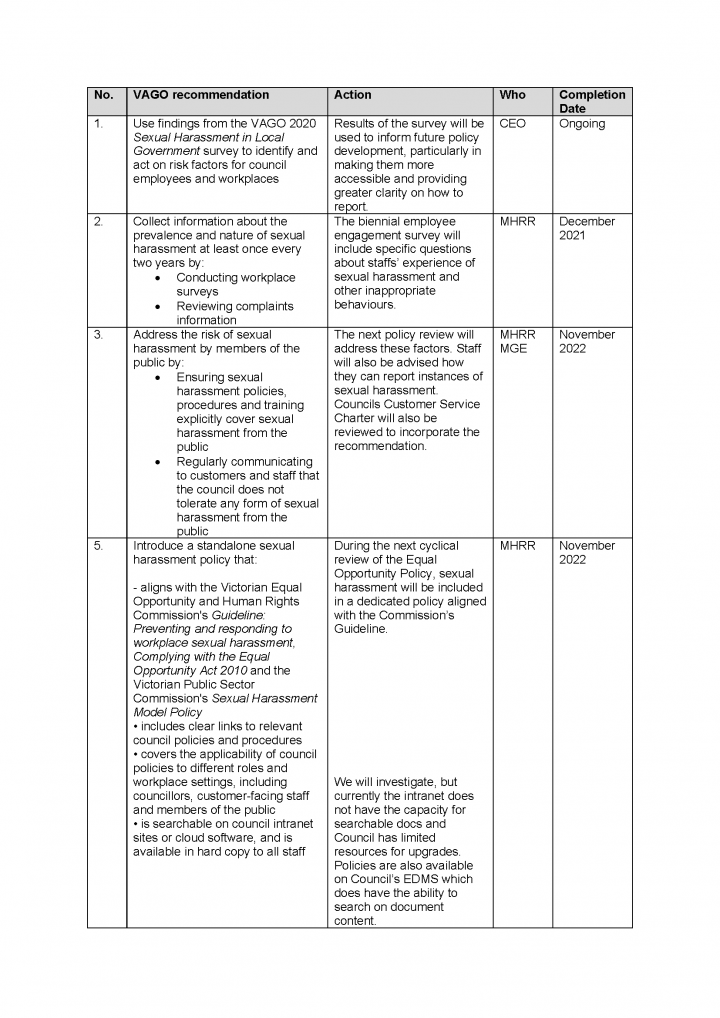
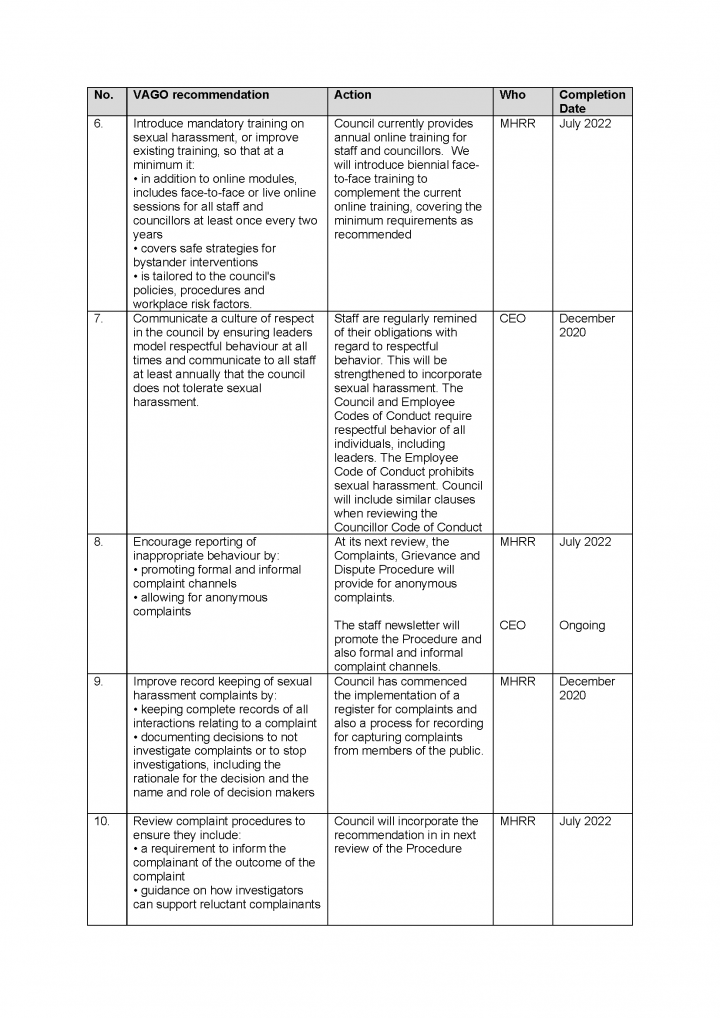

Response provided by the Chief Executive Officer, Frankston
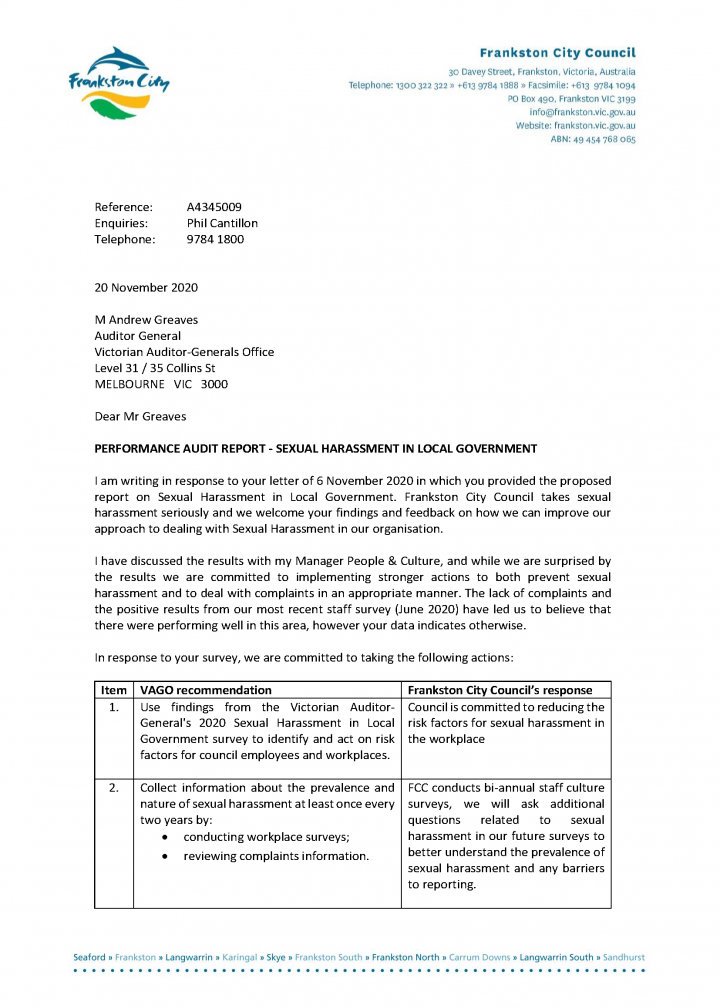
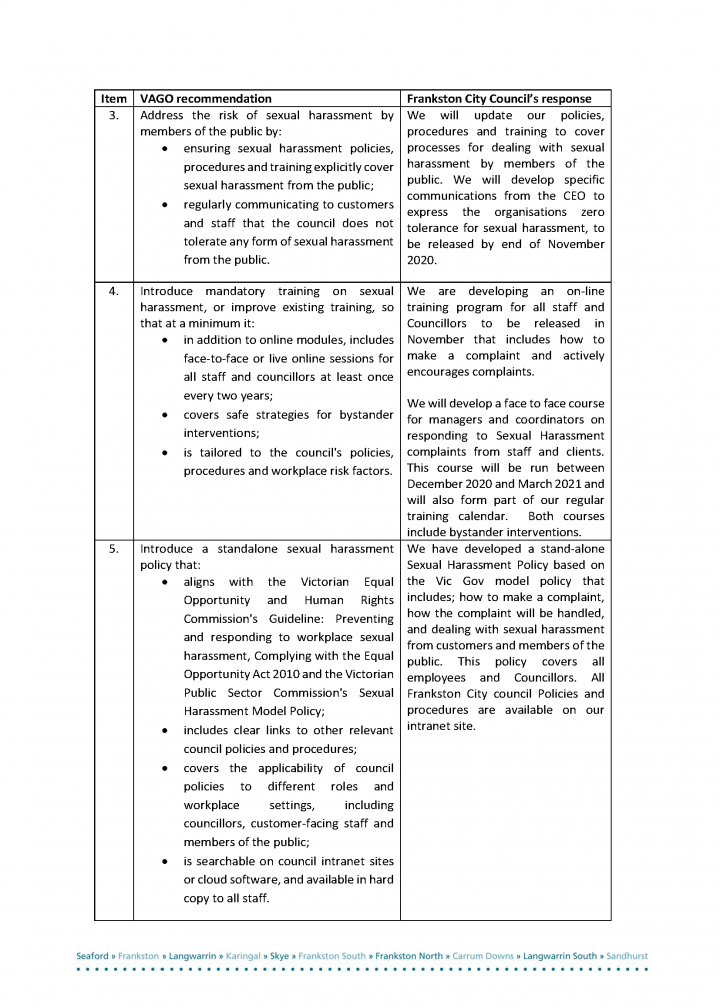
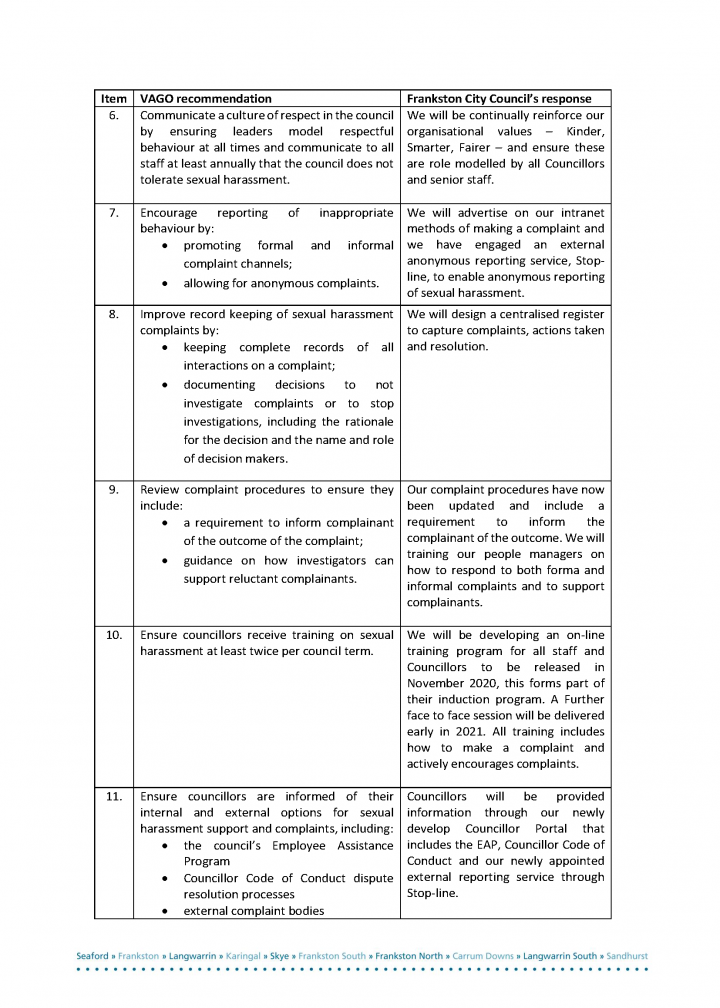
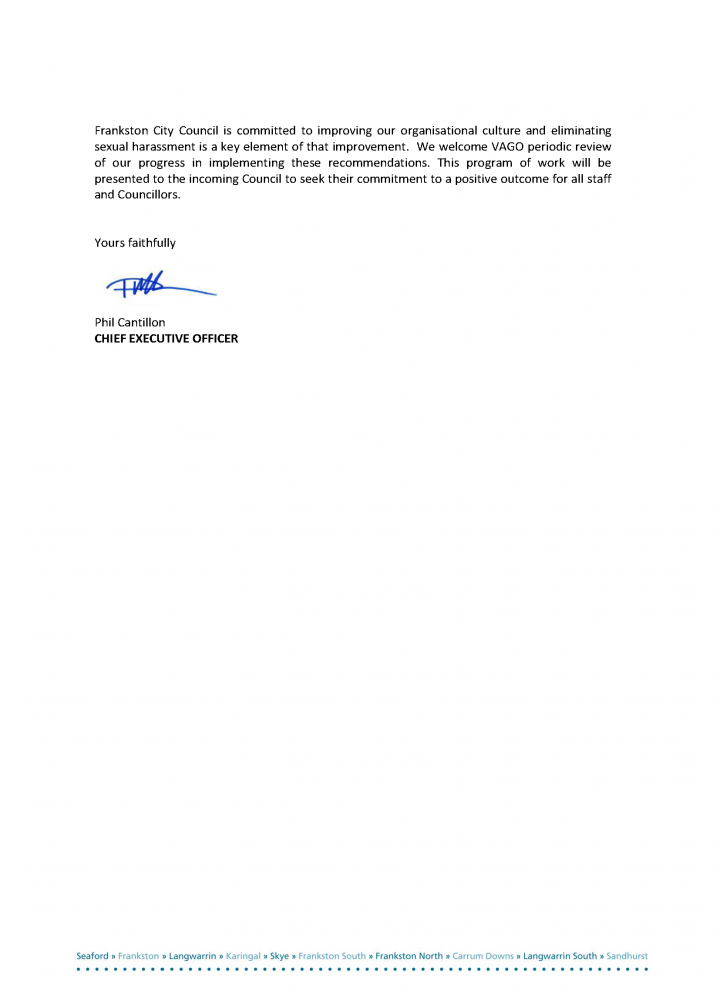
Response provided by the Chief Executive Officer, Latrobe
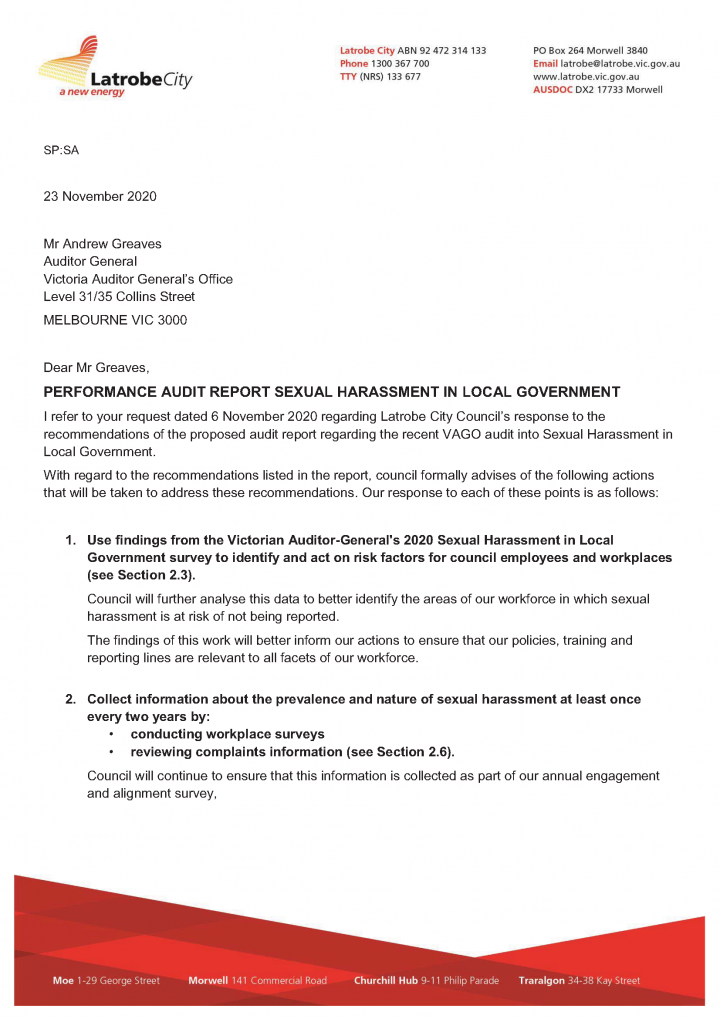
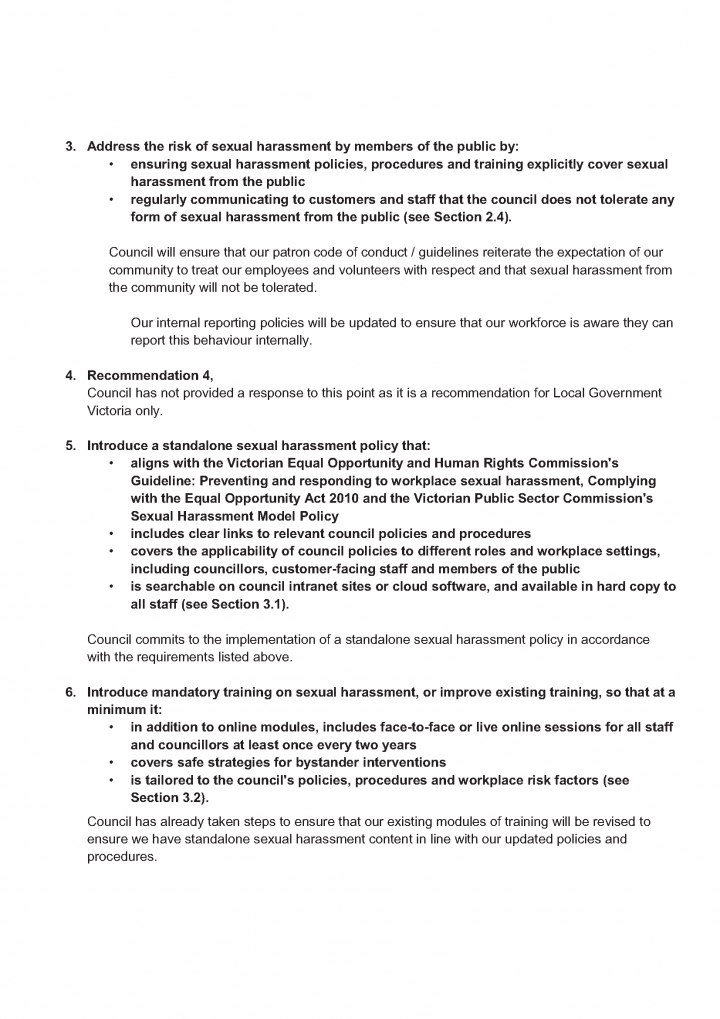
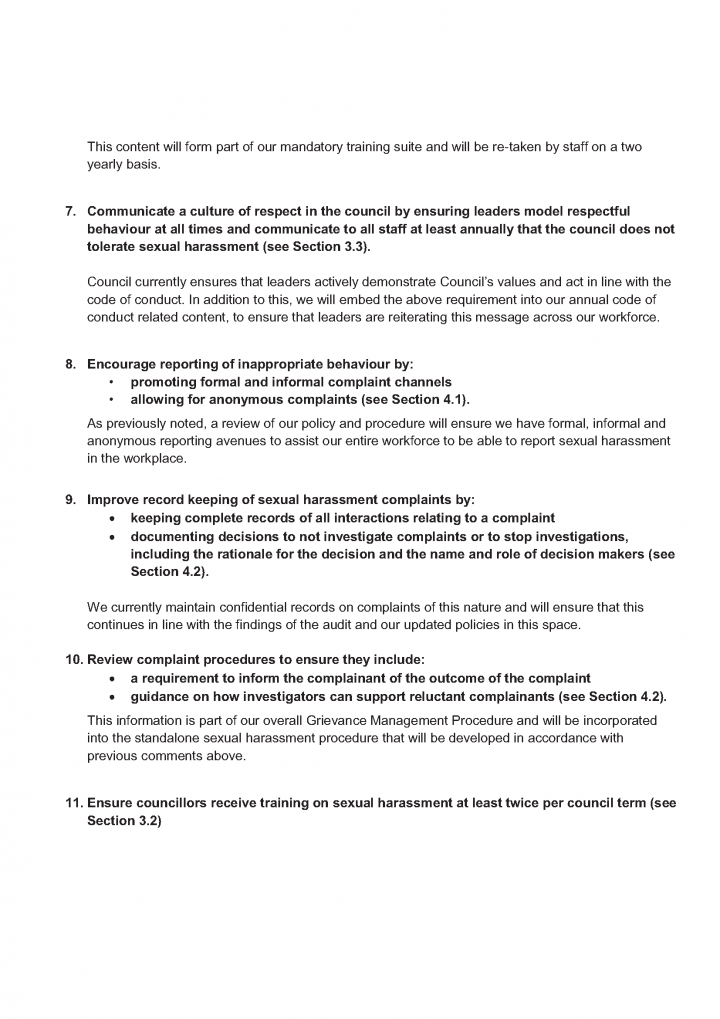
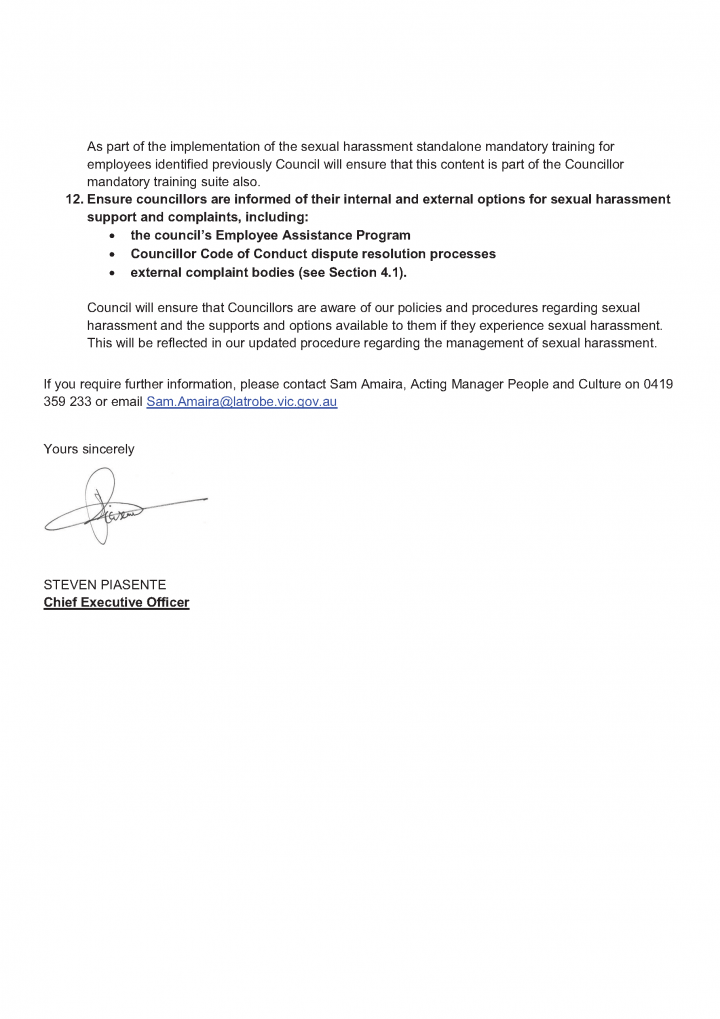
Response provided by the Chief Executive Officer, Moreland
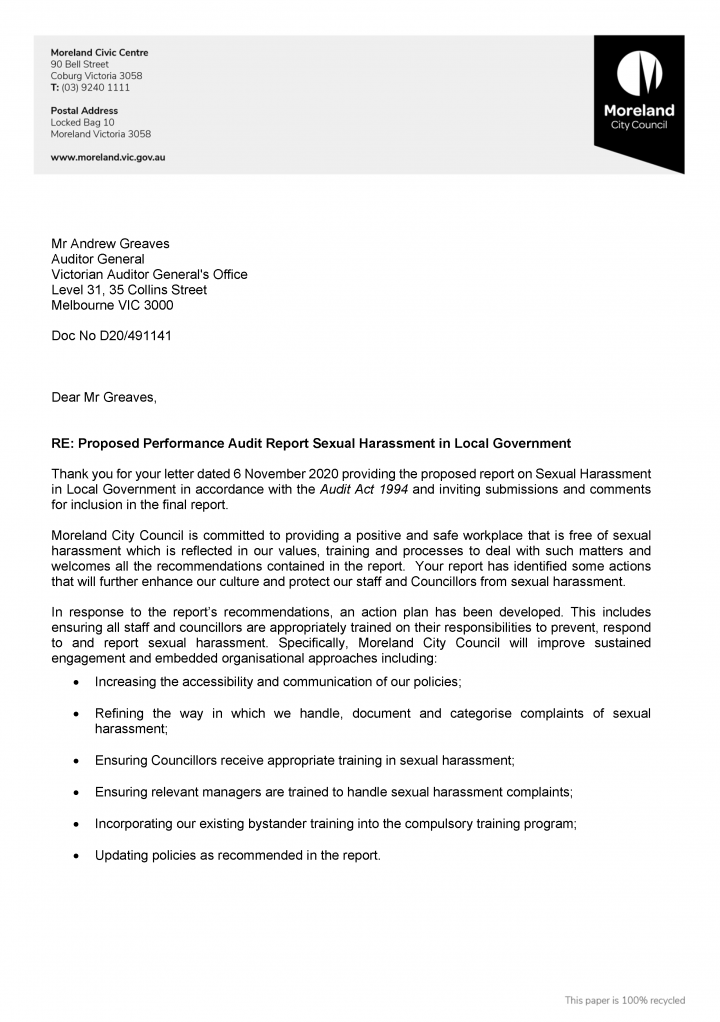
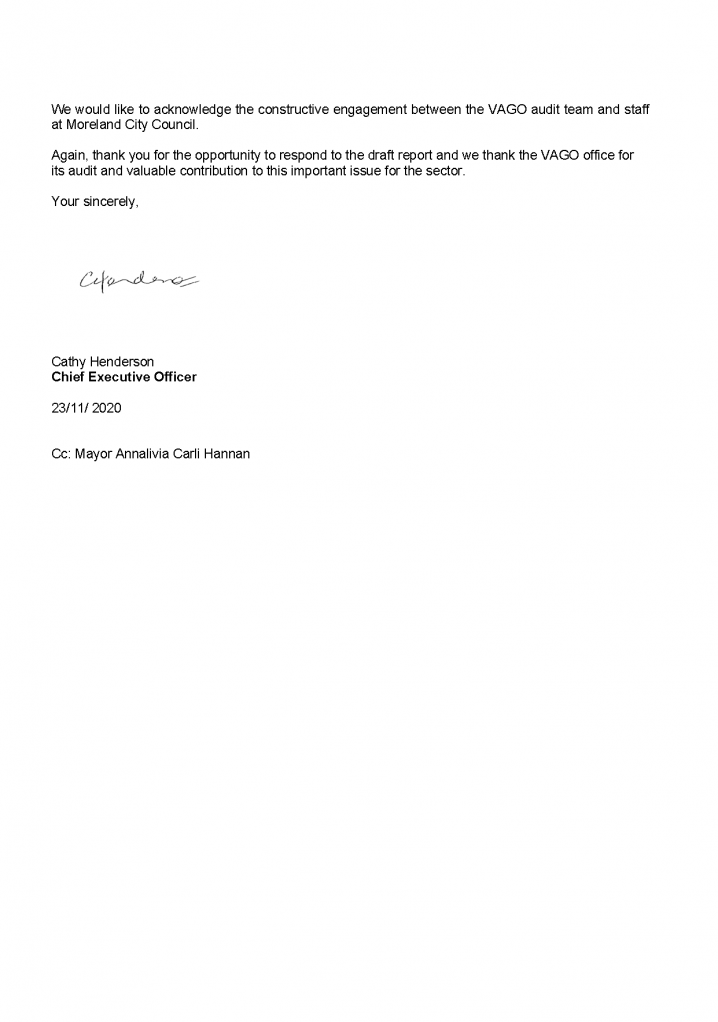
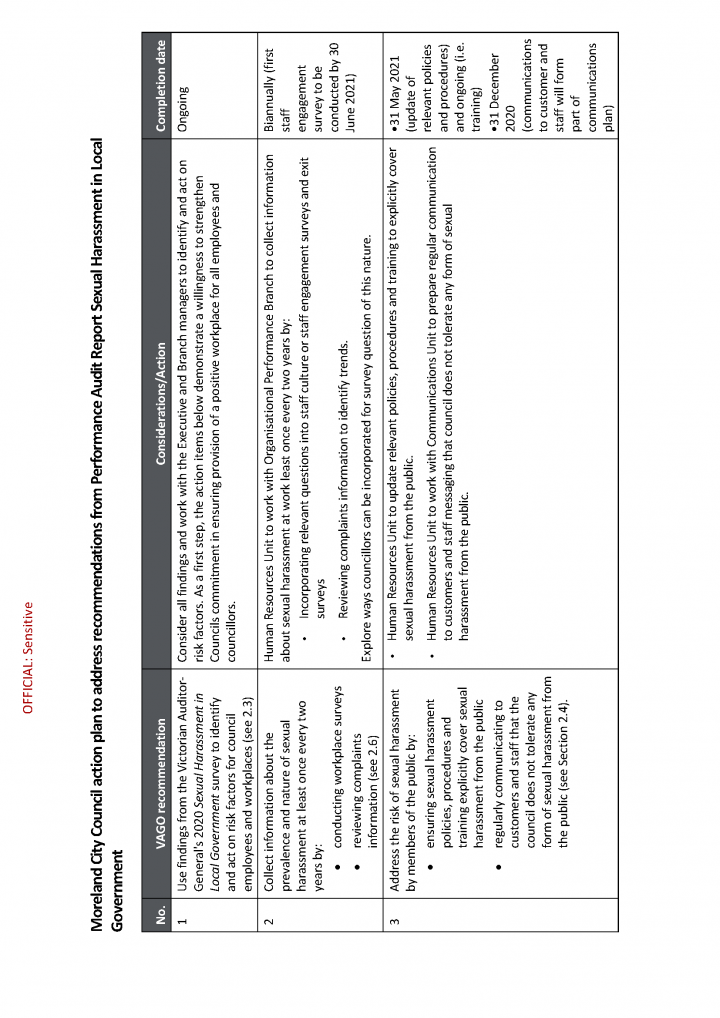
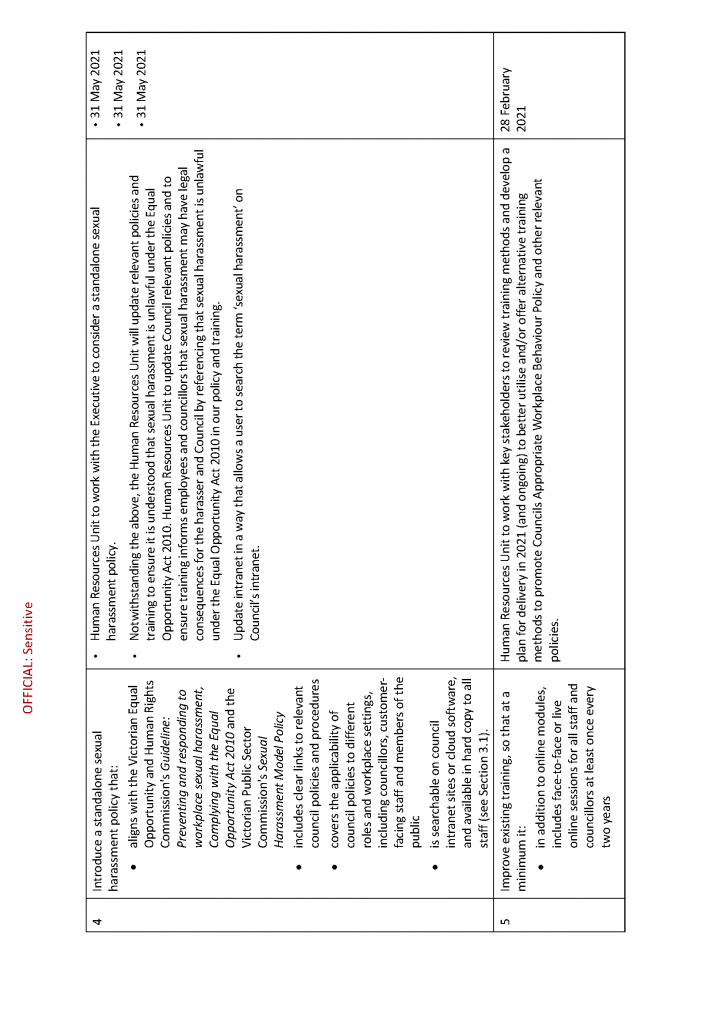
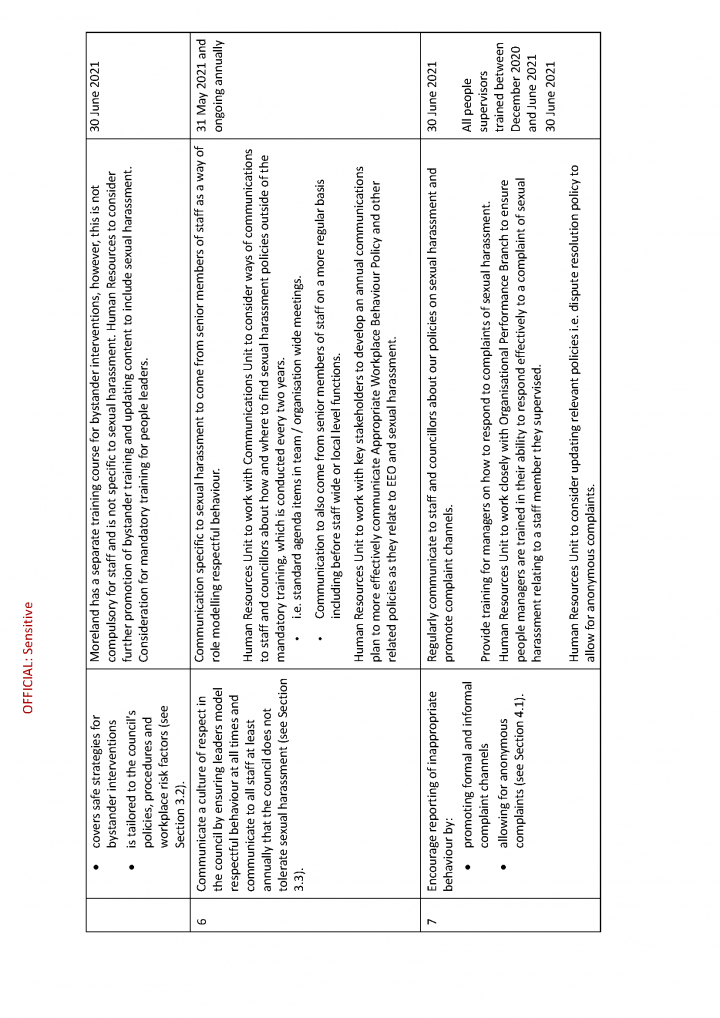
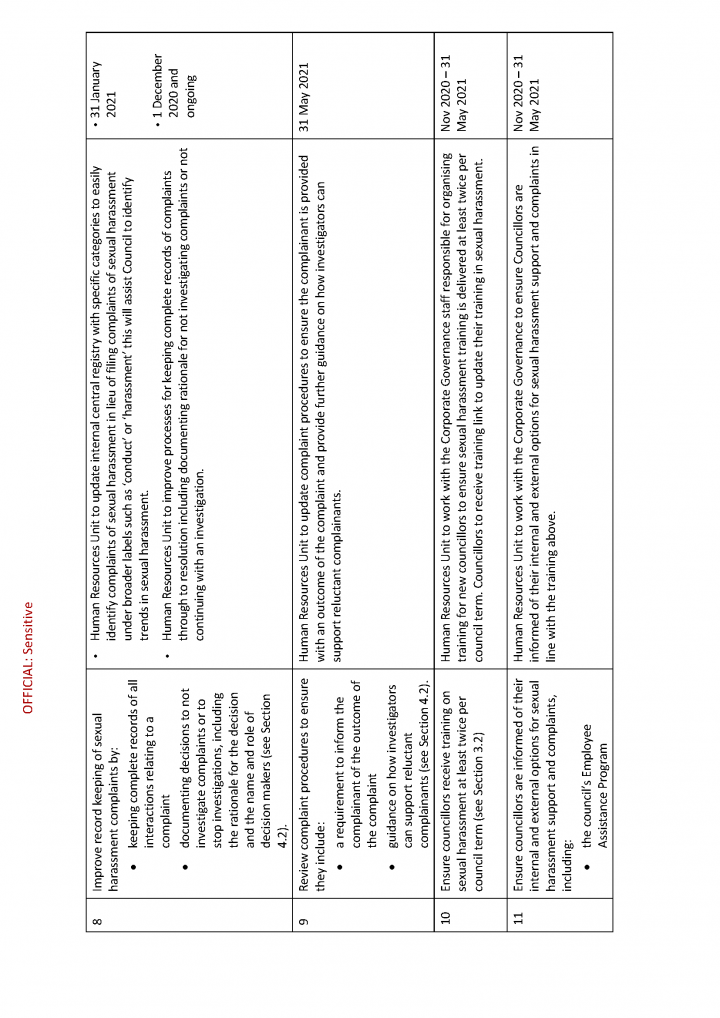

Appendix B. Acronyms, abbreviations and glossary
| Acronyms | |
|---|---|
| AHRC | Australian Human Rights Commission |
| ALGWA | Australian Local Government Women's Association |
| CEO | chief executive officer |
| EAP | employee assistance program |
| HR | human resources |
| LGBTQIA+ | lesbian, gay, bisexual, trans and gender diverse, queer, questioning, intersex and asexual |
| LGV | Local Government Victoria |
| MAV | Municipal Association of Victoria |
| PMS | People Matter Survey |
| VAGO | Victorian Auditor-General's Office |
| VEOHRC | Victorian Equal Opportunity and Human Rights Commission |
| VPS | Victorian public service |
| VPSC | Victorian Public Sector Commission |
| Abbreviations | |
|---|---|
| 2019 MAV survey | The Municipal Association of Victoria’s Gender Equality and Preventing Violence Against Women Survey of Victorian Councils 2018/2019 |
| AHRC National Inquiry | The Australian Human Rights Commission's National Inquiry into Sexual Harassment in Australian Workplaces |
| AHRC National Survey 2018 | The Australian Human Rights Commission's Everyone’s business: Fourth national survey on sexual harassment in Australian workplaces |
| Ararat | Ararat Rural City Council |
| Corangamite | Corangamite Shire Council |
| Frankston | Frankston City Council |
| Latrobe | Latrobe City Council |
| the model policy | Sexual Harassment Model Policy |
| Moreland | Moreland City Council |
| the registrar | Principal Councillor Conduct Registrar |
| VEOHRC guideline | The Victorian Equal Opportunity and Human Rights Commission's Guideline: Preventing and responding to workplace sexual harassment—Complying with the Equal Opportunity Act 2010 |
Appendix C. Scope of this audit
| Who we audited | What we assessed | What the audit cost |
|---|---|---|
|
We assessed whether councils:
|
The cost of this audit was $560 000. |
Our methods
As part of this audit we:
- audited five councils, including reviewing their:
- policies on sexual harassment
- training materials and records
- complaint procedures
- sexual harassment complaints from the last five years.
- conducted a sector-wide survey (see Appendix E).
We selected the five councils as a representative spread of council types and sizes.
We conducted our audit in accordance with the Audit Act 1994 and ASAE 3500 Performance Engagements. We complied with the independence and other relevant ethical requirements related to assurance engagements. We also provided a copy of the report to the Department of Premier and Cabinet.
Appendix D. Legislation, policy and guidance
FIGURE D1: Legislative framework
| Source | Type | Requirements/guidance |
|---|---|---|
|
Equal Opportunity Act 2010 |
Victorian legislation |
Makes it unlawful to sexually harass anyone in an employment situation. Creates a positive duty for employers to prevent and eliminate sexual harassment in their workplaces. |
|
Sex Discrimination Act 1984 |
Commonwealth legislation |
Makes it unlawful to sexually harass anyone in an employment situation. |
|
Local Government Act 2020 |
Victorian legislation |
Outlines that sexual harassment by a councillor can constitute misconduct, serious misconduct or gross misconduct. Makes it compulsory for Councillor Codes of Conduct to prohibit sexual harassment (from 2020 elections onwards). |
|
Occupational Health and Safety Act 2004 |
Victorian legislation |
Obliges employers to provide a safe workplace for employees and anyone attending their workplaces. |
|
Equal Opportunity Act 2010, Preventing and responding to workplace sexual harassment (2020) |
Better practice guide |
Outlines six minimum standards for employers to comply with their positive duty. Employers should:
|
|
Model Policy for the Prevention of Sexual Harassment in the Workplace (2018) |
Better practice guide |
VPSC published a model policy on sexual harassment to drive better practice and consistency across the public sector. Sets out key features of a good sexual harassment policy. |
Source: VAGO.
Appendix E. Survey methodology
We conducted a survey about sexual harassment in local government. Our survey asked about:
- individual experiences of sexual harassment
- why respondents did or did not complain
- sexual harassment policies and training
- views on council communication and prevention.
To help participating councils address sexual harassment, we shared their de identified results with their mayor and CEO.
Interpreting data in this report
Although survey data is the best source we have for understanding the prevalence of sexual harassment, it is limited by response rates. It may not capture all staff who experience sexual harassment. It may also over-represent the prevalence of sexual harassment, as those who have experienced it may be more likely to complete an optional survey on the topic.
Unless specified otherwise, the data in this report has a margin of error of less than plus or minus 5 per cent at a confidence level of 95 per cent. The margin of error on the overall prevalence of sexual harassment was less than 1 per cent.
A margin of error shows how far away results could be from the true value.
A confidence level shows how confident you are that the true value sits within the margin of error.
Employees without email addresses
Across the participating councils, approximately 8 500 employees did not have council email addresses, equalling approximately 17 per cent of the total workforce. These employees were primarily casual staff or outdoor workers such as crossing supervisors.
We could not directly email the survey to these employees, so we provided councils with an open survey link to distribute to them. However, we received too few responses from these employees from each council to use in our analysis.
Response rate
The survey was open to staff at 75 of 79 Victorian councils. Four councils did not participate:
- Greater Geelong City Council
- Maribyrnong City Council
- Moorabool Shire Council
- Northern Grampians Shire Council.
The survey was open to councillors from all 79 councils. We sent the survey directly to participants, except at two councils that opted to distribute the survey themselves.
The survey was open for four weeks in June 2020 and received 10 344 responses. We removed responses from employees without email addresses, bringing our response total to 9 939. Our overall response rate was 24 per cent, but at individual councils this ranged from 8 per cent to 64 per cent.
FIGURE E1: Council participation and response rate by council category
| Council category | Participating councils | Number of responses | Response rate (%) |
|---|---|---|---|
| Metropolitan | 21/22 | 3 969 | 20 |
| Interface | 9/9 | 2 269 | 25 |
| Regional cities | 10/11 | 1 357 | 24 |
| Large rural shire | 18/19 | 1 561 | 28 |
| Small rural shire | 17/18 | 783 | 38 |
| All | 75/79 | 9 939 | 24 |
Note: Response rates do not include staff without council email addresses. The survey was open to all councillors, even at the four councils that did not open the survey to their staff. We received two responses from councillors at non-participating councils.
Source: VAGO LG Survey 2020.
Survey design
Our survey did not directly ask participants if they had experienced sexual harassment. Instead we measured the prevalence of sexual harassment by:
- providing respondents with a list of unwelcome behaviours that are likely to constitute sexual harassment (see Section 2.2, Figure 2E)
- asking them how often they had experienced these behaviours in the past 12 months (to June 2020).
Respondents may be unsure if their experiences count as sexual harassment. By specifying behaviours, we did not rely on respondents understanding the legal definition of sexual harassment.
This approach is in line with the AHRC National Survey 2018 and the Australian Bureau of Statistics' Personal Safety Survey, which it conducts every five years.
Other surveys on sexual harassment
The surveys we used to compare to ours also measured prevalence by listing behaviours, rather than directly asking respondents if they experienced sexual harassment. Figure E2 outlines the methodology and response rates for these surveys.
FIGURE E2: Survey methodologies of related workforce surveys
| Survey | Prevalence of sexual harassment (%) | Methodology and response rate |
|---|---|---|
|
VPSC's 2019 PMS |
7 |
|
|
VAGO’s survey of Victorian public sector employees 2019 |
29 |
|
|
AHRC National Survey 2018 |
33 |
|
Note: AHRC survey results cover a five-year period.
Source: VAGO LG Survey 2020.
Appendix F. Survey Data
This appendix contains detailed data from our survey. You can also view this on our data dashboard on our website at www.audit.vic.gov.au.
Prevalence of sexual harassment
FIGURE F1: Metropolitan council prevalence of sexual harassment
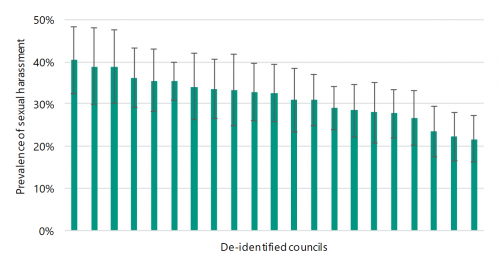
Note: Error bars represent the margin of error.
Source: VAGO LG Survey 2020.
FIGURE F2: Interface council prevalence of sexual harassment
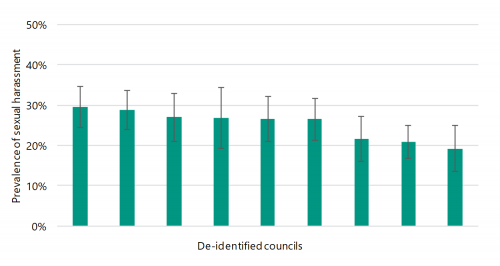
Note: Error bars represent the margin of error.
Source: VAGO LG Survey 2020.
FIGURE F3: Regional city council prevalence of sexual harassment
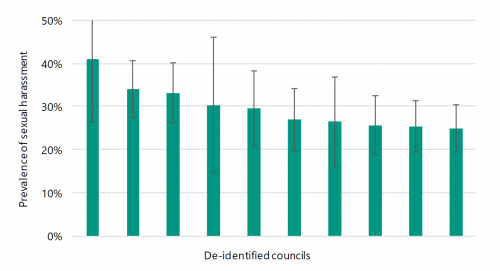
Note: Error bars represent the margin of error.
Source: VAGO LG Survey 2020.
FIGURE F4: Large shire council prevalence of sexual harassment
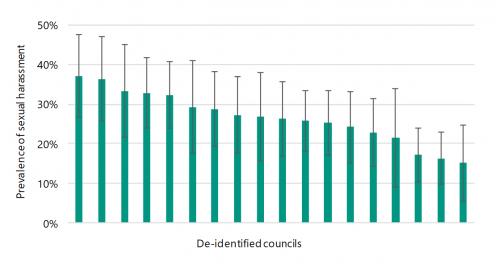
Note: Error bars represent the margin of error.
Source: VAGO LG Survey 2020.
FIGURE F5: Small shire council prevalence of sexual harassment
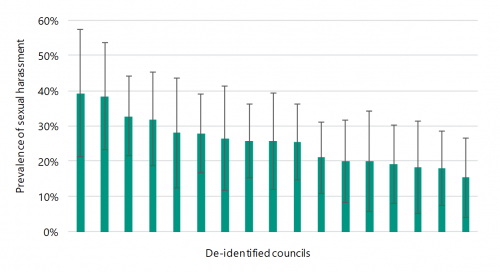
Note: Error bars represent the margin of error.
Source: VAGO LG Survey 2020.
FIGURE F6: Prevalence by role type
| Role | Number who experienced sexual harassment | Percentage who experienced sexual harassment (%) |
|---|---|---|
| Councillor | 41 | 30 |
| Customer-facing | 653 | 28 |
| Outdoors/depot | 291 | 28 |
| Offices/administration | 1 746 | 28 |
| All respondents | 2 807 | 28 |
Note: 237 respondents did not give their role type.
Source: VAGO LG Survey 2020.
Experiences
FIGURE F7: Sexual harassment behaviours experienced by role type
| Type of sexual harassment | All respondents | Councillor | Customer-facing | Offices and administration | Outdoor or depot |
|---|---|---|---|---|---|
| Intrusive questions about personal life/appearance | 1 793 | 26 | 456 | 1 069 | 185 |
| Sexually suggestive comments or jokes | 1 647 | 26 | 369 | 1 023 | 184 |
| Staring or leering | 674 | 12 | 181 | 394 | 63 |
| Inappropriate physical contact | 525 | 10 | 147 | 301 | 47 |
| Unwelcome touching, hugging, cornering or kissing | 522 | 11 | 144 | 302 | 46 |
| Other unwelcome conduct | 319 | 8 | 87 | 179 | 29 |
| Sexual gestures, indecent exposure or inappropriate display of body | 207 | 3 | 62 | 103 | 35 |
| Repeated/inappropriate date invitations | 187 | 6 | 56 | 94 | 23 |
| Advances on email/social media | 136 | 2 | 29 | 84 | 15 |
| Sexually explicit pictures, posters or gifts | 115 | 2 | 25 | 50 | 29 |
| Sexually explicit posts or messages on social media | 108 | 6 | 20 | 48 | 26 |
| Sexually explicit email/text | 83 | 2 | 16 | 43 | 20 |
| Request or pressure for sex | 40 | 2 | 9 | 16 | 11 |
Note: Respondents could select more than one type of harassment.
Source: VAGO LG Survey 2020.
FIGURE F8: Workplace setting of sexual harassment by role type
| Setting | All respondents | Councillor | Customer-facing | Offices and administration | Outdoor or depot |
|---|---|---|---|---|---|
| Day-to-day work | 2 531 | 28 | 600 | 1 573 | 259 |
| Social event | 243 | 9 | 40 | 166 | 21 |
| Online | 110 | 3 | 25 | 68 | 12 |
| Other | 94 | 3 | 19 | 56 | 13 |
| Conference, retreat or off-site | 86 | 6 | 15 | 54 | 8 |
| Council meeting | 66 | 15 | 11 | 35 | 3 |
Note: Respondents could select more than one setting.
Source: VAGO LG Survey 2020.
FIGURE F9: Relationship between harasser and the victim by role type
| Relationship to the harasser | All respondents | Councillor | Customer-facing | Offices and administration | Outdoor or depot |
|---|---|---|---|---|---|
| Same level co-worker | 1 161 | 0 | 227 | 778 | 124 |
| Senior co-worker | 925 | 3 | 156 | 655 | 82 |
| Member of the public | 632 | 14 | 292 | 227 | 78 |
| Junior co-worker | 503 | 1 | 89 | 322 | 80 |
| Direct manager | 340 | 2 | 74 | 214 | 37 |
| Councillor | 165 | 29 | 20 | 107 | 5 |
| Contractor/consultant | 152 | 0 | 32 | 93 | 21 |
Note: Respondents could select more than one relationship.
Source: VAGO LG Survey 2020.
Impact
FIGURE F10: Impacts of sexual harassment for men and women
| Impact | All respondents | Female | Male |
|---|---|---|---|
| No impact | 1 547 | 994 | 530 |
| Impact on mental health | 706 | 534 | 150 |
| Lowered self-esteem and confidence | 584 | 441 | 126 |
| Other | 396 | 320 | 66 |
| Impact on employment | 100 | 55 | 40 |
| Deterioration of relationships | 58 | 42 | 16 |
| Financial loss | 30 | 20 | 8 |
Note: Respondents could select more than one impact. We received too few responses from respondents with a self-described gender identity to report on levels of harassment for that cohort.
Source: VAGO LG Survey 2020.
Complaints
FIGURE F11: Responses to sexual harassment by role type
| Response | All respondents | Councillor | Customer-facing | Offices and administration | Outdoor or depot |
|---|---|---|---|---|---|
| Pretended it didn't bother me | 1 204 | 19 | 280 | 770 | 108 |
| Tried to laugh it off or forget about it | 1 047 | 11 | 245 | 676 | 89 |
| Avoided the person(s) | 762 | 12 | 202 | 457 | 68 |
| Told the person the behaviour was not OK | 685 | 13 | 174 | 382 | 89 |
| Told a co-worker | 529 | 2 | 144 | 322 | 45 |
| Told a friend or family member | 351 | 6 | 98 | 199 | 39 |
| Told my manager | 291 | 1 | 93 | 165 | 23 |
| Avoided places behaviour might occur | 261 | 4 | 74 | 151 | 21 |
| Other, please specify here | 213 | 10 | 42 | 132 | 23 |
| Took time off work | 62 | 2 | 15 | 34 | 6 |
| Made formal complaint to council | 54 | 1 | 18 | 18 | 14 |
| Asked for transfer (e.g. role, location, roster) | 30 | 0 | 14 | 15 | 0 |
| Made formal external complaint | 20 | 2 | 6 | 7 | 4 |
Note: Respondents could select more than one response.
Source: VAGO LG Survey 2020.
FIGURE F12: Barriers to making a formal complaint by role type
| Reason for not making complaint | All respondents | Councillor | Customer-facing | Offices and administration | Outdoor or depot |
|---|---|---|---|---|---|
| Didn't think it was serious enough | 1 651 | 15 | 382 | 1 086 | 134 |
| Didn't think it would make a difference | 677 | 10 | 174 | 405 | 66 |
| Believed there would be negative consequences for me | 661 | 12 | 147 | 398 | 74 |
| Harassment stopped | 393 | 5 | 108 | 238 | 34 |
| Thought complaint process would be embarrassing or difficult | 367 | 8 | 94 | 218 | 34 |
| Other | 358 | 6 | 75 | 230 | 37 |
| Didn't want negative consequences for harasser | 260 | 1 | 61 | 169 | 23 |
| No longer had contact with the person(s) | 171 | 4 | 62 | 84 | 16 |
| Didn't know how | 80 | 0 | 23 | 42 | 12 |
| Told not to by co-worker | 30 | 1 | 9 | 16 | 1 |
| Told not to by family or friends | 12 | 1 | 3 | 6 | 1 |
Note: Respondents could select more than one barrier.
Source: VAGO LG Survey 2020.
FIGURE F13: Knowledge about reporting sexual harassment and accessing support by role type
| Know how to … | All respondents (%) | Councillor (%) | Customer-facing (%) | Offices and administration (%) | Outdoor or depot (%) |
|---|---|---|---|---|---|
| make a formal complaint of sexual harassment | 84 | 88 | 83 | 84 | 89 |
| access employee assistance program | 93 | 70 | 93 | 95 | 86 |
| get help if I or a co-worker experienced sexual harassment | 92 | 89 | 92 | 92 | 94 |
Source: VAGO LG Survey 2020.
Training
FIGURE F14: Training rates and manager confidence by role type
| Role type | Respondents that completed training at induction (%) | Managers confident in handling sexual harassment complaints (%) |
|---|---|---|
| All respondents | 40 | 89 |
| Councillor | 21 | Not applicable |
| Customer-facing | 38 | 88 |
| Offices/administration | 40 | 89 |
| Outdoors/depot | 45 | 92 |
Source: VAGO LG Survey 2020.
FIGURE F15: Training rates and manager confidence by employment type
| Employment type | Percentage of respondents that completed training at induction (%) | Percentage of managers confident in handling sexual harassment complaints (%) |
|---|---|---|
| Casual | 34 | 85 |
| Full-time (contract) | 50 | 94 |
| Full-time (ongoing) | 41 | 89 |
| Part-time (contract) | 41 | 88 |
| Part-time (ongoing) | 31 | 83 |
Source: VAGO LG Survey 2020.
FIGURE F16: Induction training rates and manager confidence by length of employment
| Length of employment | Respondents that completed training at induction (%) | Managers confident in handling sexual harassment complaints (%) |
|---|---|---|
| Less than a year | 53 | 91 |
| 1–2 years | 51 | 88 |
| 3–5 years | 42 | 88 |
| 6–10 years | 39 | 89 |
| 11–20 years | 31 | 90 |
| Over 20 years | 19 | 89 |
Source: VAGO LG Survey 2020.
Leadership and communication
FIGURE F17: Does your council communicate annually about how it is addressing sexual harassment?
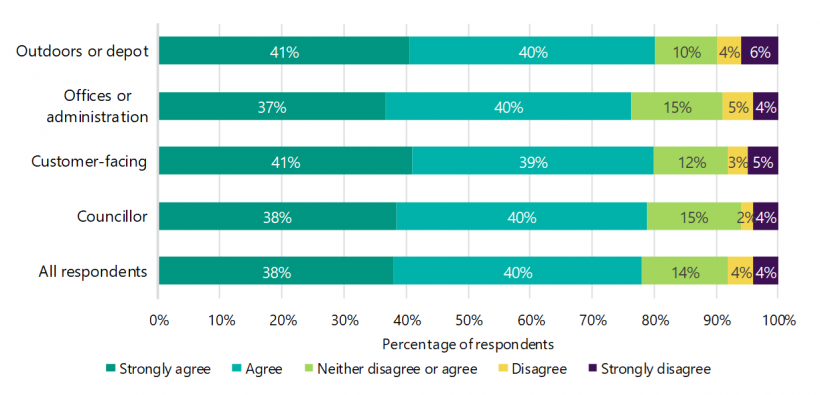
Source: VAGO LG Survey 2020.
FIGURE F18: Views on council performance by role type
| Role type | Do you believe that sexual harassment is not a problem at your council? (%) | Do you believe that your council is taking sexual harassment seriously? (%) |
|---|---|---|
| All respondents | 61 | 77 |
| Councillor | 68 | 84 |
| Customer-facing | 55 | 76 |
| Offices/administration | 64 | 78 |
| Outdoors/depot | 63 | 81 |
Source: VAGO LG Survey 2020.
